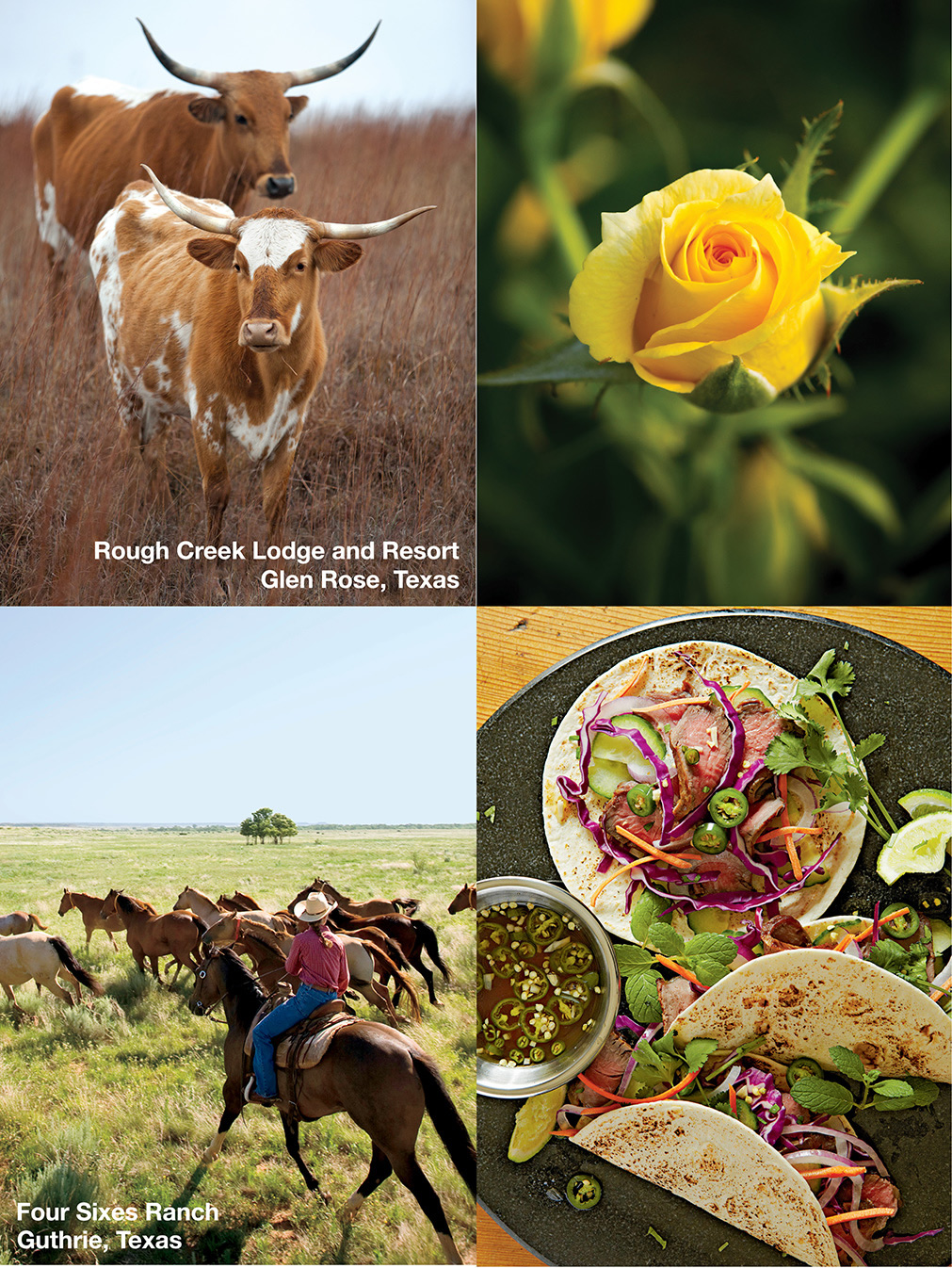
Big, Bold Texas
In his sweeping historical novel Texas, Pulitzer Prize-winning author James Michener writes: “Texas is so big that you can live your life within its limits and never give a damn about what anyone in Boston or San Francisco thinks.” Indeed, the bigness of Texas cannot be overstated.
With more than 267,000 square miles, Texas makes up 7.4 percent of the nation’s total land mass. It’s the largest state in the Lower 48. More land is farmed, more sheep are raised, and more wool is produced in Texas than in any other state. More species of bats live here, too, including 1.5 million of the Mexican free-tailed species that congregate under the Congress Avenue Bridge in Austin each summer.
But it’s not just the grand physical size—it’s the big attitude. You can find lots of big hair and big talkin’ in Texas. And no one is more proud of this image than Texans themselves. They’re a varied and diverse crowd, united only by a notion that theirs is the best state. The legendary pride of Texans probably comes in no small part from the state’s origins. If you were paying attention in history class, you’ll know Texas fought for its independence from Mexico and was its own sovereign nation from 1836 to 1845.
It’s also big ideas. The Lone Star State is home to one of America’s first suspension bridges (the Waco Bridge built in 1870), the country’s first domed stadium (the Astrodome built in Houston in 1965), and the world’s first rodeo (held in Pecos on July 4, 1883, although other states also claim this “first”). Dr Pepper was invented in Waco, and in Texas, it is illegal to graffiti someone else’s cow.
Fueling a lot of the big aspirations, independence, and swagger is big money. AT&T, Exxon, Southwest Airlines, J.C. Penney, Kimberly-Clark, Dell, and Marathon Oil: These Fortune 500 companies are all headquartered in Texas. What brought the money in the first place was the oil. And what followed in Texas’s biggest cities, especially Dallas and Houston, was a proliferation of got-rich-quick people trying to figure out how to class up the place.
Thanks in no small part to oil monies, Texas now offers citizens and visitors some serious fine arts.
Take Dallas, for example: I.M. Pei, the great modernist Chinese-American architect, designed its sharp-angled, impressively windowed Meyerson Symphony Center. (It was funded in large part by H. Ross Perot, the Texarkana native, former two-time presidential candidate, and founder of Electronic Data Systems who made a mint when he sold the company to General Motors in 1984 and again when he sold his second company, Perot Systems, to Dell for $3.9 billion.)
The beloved Dallas Symphony Orchestra has played Carnegie Hall, the Kennedy Center, and the great halls of Europe. And the Nasher Sculpture Center, opened in 2003, features expansive indoor and outdoor garden spaces in which you can view works by Joan Miró, Alexander Calder, and Isamu Noguchi.
San Antonio boasts the Nelson A. Rockefeller Center for Latin American Art at the San Antonio Museum of Art. Its centerpiece: a staggering collection of Mexican folk art that provides an artistic connection to the state’s Mexican heritage that no other museum in the world can rival.
Austin claims the annual South by Southwest Music and Media Conference, a massive showcase for up-and-coming and established bands, record labels, independent filmmakers, and the techie set. It’s a pop-culture fiesta like no other, a kind of modern Woodstock for a new breed of hippies, ambitious performers, and media enthusiasts with money and stamina.
Football is a big deal all over the South, but it’s something else entirely in Texas, as anyone who has ever been there knows. Whether it’s a kids’ team playing or the pros, Texans’ devotion to the pigskin is unmatched. “Sectional football games have the glory and despair of war,” John Steinbeck wrote, “and when a Texas team takes the field against a foreign state, it is an army with banners.”
The pinnacle, of course, is the Dallas Cowboys, a franchise founded in 1960 and coached for 29 years by football legend Tom Landry. The cheerleading squad, which debuted in earnest in the 1972-1973 season, is no small part of the attraction. Incidentally, while basketball is generally not a big deal in Texas, the San Antonio Spurs are hometown hoopster heroes—especially the “Twin Towers” of (now retired, ever beloved) David “The Admiral” Robinson and Tim Duncan. The team hasn’t missed the NBA playoffs since 1997.
To discuss Texas properly, at a certain point you’ve got to break it down into manageable chunks, the first and most obvious being the Dallas-Fort Worth area. What do most Americans know about Dallas? They know about J.R. Ewing and his family’s Southfork ranch, they know that this is where Neiman Marcus was founded, and they know that President John Fitzgerald Kennedy was shot here in November 1963 (more about JFK here).
Nearby Fort Worth is much less discussed but no less full of wealth and bluster. “Where the West Begins” is its motto, after all.
Once the terminus of the Chisholm Trail, the well-worn route cowboys used when they drove cattle from Texas ranches to Kansas railheads, Fort Worth today is less honky-tonk than it is Bassville, a nod to oil baron Sid Bass and his father and brothers, who all number among the world’s billionaires. The Bass family has given the city the Nancy Lee and Perry R. Bass Performance Hall. Inspired by the old limestone European opera houses, it’s a major Fort Worth landmark and a big part of the revitalized downtown.

Everything’s bigger in Texas: the hair, the talk, the attitude. From cowboys to musicians to artists, Texans are a proud bunch, united by the notion that theirs is the best state.
Houston’s infrastructure could never quite keep up with its rapid expansion. Because of this, today it is a thriving, vibrant, busy-feeling city but not an especially beautiful one. It does, however, have real pockets of gorgeousness.
Take the lushly landscaped River Oaks neighborhood, one of the wealthiest neighborhoods in America. It’s got its own country club and chamber orchestra, and its notable residents have included oil baron Oscar Wyatt, professional basketball player Clyde Drexler, and the tough-talking Texas journalist Molly Ivins.
And the Bayou Bend Collection and Gardens, which offers free general admission one day a week, has an honest-to-goodness lazy river flowing through its 14 acres of statues, fountains, and magnificent azalea gardens.
Oil money built Houston and sustained it for a long, long time, but the city wasn’t immune to modern economic struggles. The Enron scandal, revealed in 2001, hit the city hard. What was once the nation’s seventh largest company was busted for major fraud, costing its shareholders billions and leaving a hole in the fine arts community. Enron had been a major backer of the city’s arts programs and institutions.
Today, Houston is a thriving multicultural port with some excellent culture, renowned institutions, and some incredibly serious shopping.
Start with The Galleria, the largest shopping center in Texas and the fourth largest in the country. It’s home to Saks Fifth Avenue, Nordstrom, Houston’s branch of Neiman Marcus, and not one but two Macy’s department stores—plus boutique outposts of Fendi, Gucci, Louis Vuitton, Chanel, Prada, and Valentino—not to mention 12 beauty salons, an ice-skating rink, a video game arcade, a post office, and 30 restaurants.
But wait—there’s culture, too! The Alley Theatre, running since 1947 and one of the country’s oldest theaters with stage actors in residence, has hosted world premieres for Tony Award-winning plays that went straight from there to Broadway.
Houston also has Rice University, “the Ivy League of Texas” (some student chat boards boast: “You almost forget what state you’re in!”), and Texas Medical Center, not only the largest but also one of the finest in the country.

Unlike Dallas and Houston, San Antonio had a rich culture well before foreign arrivals or oil. It’s an old Texas city—and the one with the closest ties to its Mexican roots.
The defeat became a rallying cry (“Remember the Alamo!”), inciting Texans led by Sam Houston to take down Santa Anna a couple of weeks later and win independence. The event, according to many historians, served as inspiration for Americans to forge ahead with the Mexican-American War a decade later.
Money is less a factor in San Antonio’s collective mentality than it is in many other Texas cities. By and large, San Antonio’s a lot poorer than other Texas top dogs. It’s also a lot older. Founded by Native Americans who made camps along its riverbanks, San Antonio became a Spanish mission settlement in 1718. It’s a rare Texas city with a history that doesn’t depend on foreign arrivals or oil, and it’s the one with the closest ties to its Mexican roots.
In its earliest years, San Antonio was a prime stop on the Camino Real, the “royal road” linking Mexico City to Louisiana. Nowhere is this more evident than in its food scene; San Antonio is the birthplace of Tex-Mex food.
The hybrid cuisine sprang up in the days when Texas was part of Mexico’s outer reaches and the folks who moved there from central Mexico had to make do with what they could find there, giving rise to crisp-shelled tacos, chile con queso, and chips and salsa. Award-winning food writer and Saveur co-founder Colman Andrews described Tex-Mex food as “the working-class fare of Mexico (especially northern Mexico), but cooled down and Americanized and expressed through ingredients like ground meat, garlic powder, chili powder, and processed cheese.”
The combination plate is the defining symbol of Tex-Mex and, according to Andrews, should include enchiladas (cheese or ground beef, preferably) with refried beans and seasoned Spanish rice on the side—and maybe a taco or tamale to boot. Andrews contends that Tex-Mex food is no less authentic than the regional Mexican varieties to be found south of the border.
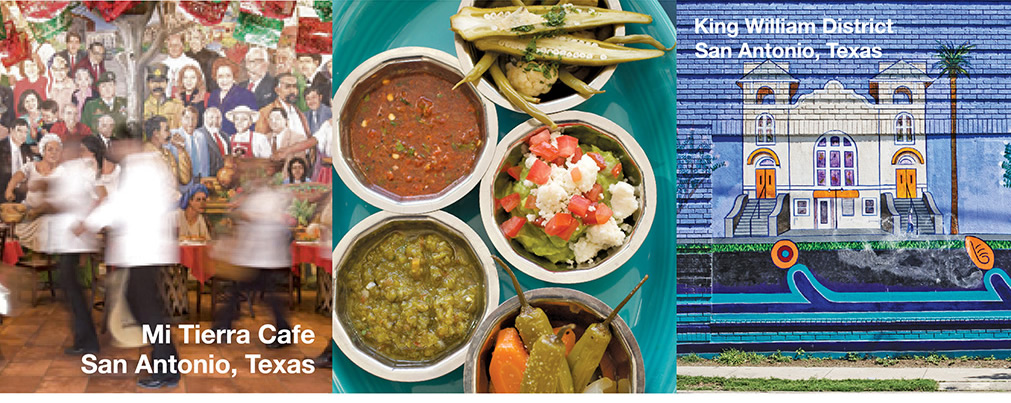
Long a prime stop between Mexico City and Louisiana, San Antonio is the birthplace of Tex-Mex food.
Austin is also the state capital, the most southerly in the continental United States, and has a huge domed pink granite Capitol to show for it. The mixture of collegiate counterculture, margaritas, and local politics does a lot to give Austin its flavor.
A major tech boom in the 1990s also did much to put Austin on the map, infusing the town with dough, which helped feed its fine arts scene. During that era, Austin’s work force grew by a full two-thirds.
The big boom was followed by a bust, but through it entrepreneur Michael Dell remained front and center in Austin’s tech revolution. Once America’s youngest Fortune 500 company chief executive and routinely among its richest, richer than the Basses or Perot, Dell made his money not in software but in hardware. He sold computers directly to the public and created a whole bunch of “Dellionaires”—folks who were among the company’s first employees—in the process.
Viewed through its food markets, Austin is both the Berkeley and the Hong Kong of the South. Opened in 1994 and modeled on the old-fashioned European food hall, the flagship Central Market Grocery Store is one of Austin’s most popular tourist destinations, claiming more than 2 million visitors a year.
It’s an enormous place with an enormous selection: 700 kinds of cheese; more than 100 varieties of saltwater and freshwater fish and seafood flown in daily from Hawaii, Ecuador, and Maine; 150 varieties of organic produce. It’s not just for locavores, for in Texas people love things from Texas and can easily find them all over. Instead, it’s a kind of food lover’s museum where it’s OK to taste and smell what’s on offer.
Whole Foods Market also began in Austin. Its flagship store opened in 1980 as a tribute to what was then called the natural foods movement (and what today we just call healthy eating). It was such a mom-and-pop organization in those days that cofounder and co-CEO John Mackey, today a powerful force in food legislation in the United States, lived in the store and reportedly bathed in its Hobart dishwasher.
Nowadays Whole Foods is most Americans’ first experience with organic food and a powerful symbol of food’s importance in our collective national culture.
Even though Austin has more dollars in circulation today than it used to, it retains a distinctively hippie feeling. Bumper stickers, T-shirts, and graffiti proclaim “Keep Austin Weird.” Austinites love their reputation as laid-back, music-and-beer-loving, barbecue-eating, bicycle-riding folks who just like a little peace (and some organic kale on the side.)
Excellent examples include singer Willie Nelson and actor Matthew McConaughey, who both live here, as do tennis ace Andy Roddick and his Sports Illustrated model wife, Brooklyn Decker, and noted film-makers Robert Rodriguez and Richard Linklater. Billy Bob Thornton has a house here, and so does Led Zeppelin’s lead singer, Robert Plant. And celebrities from Bill Murray to Drew Barrymore drop in during the annual music, tech, and cultural happening that is South by Southwest.
Austin is a big-in-its-own-right, bold-in-its-own-way draw for a state that has more than its share of big, bold enticements.
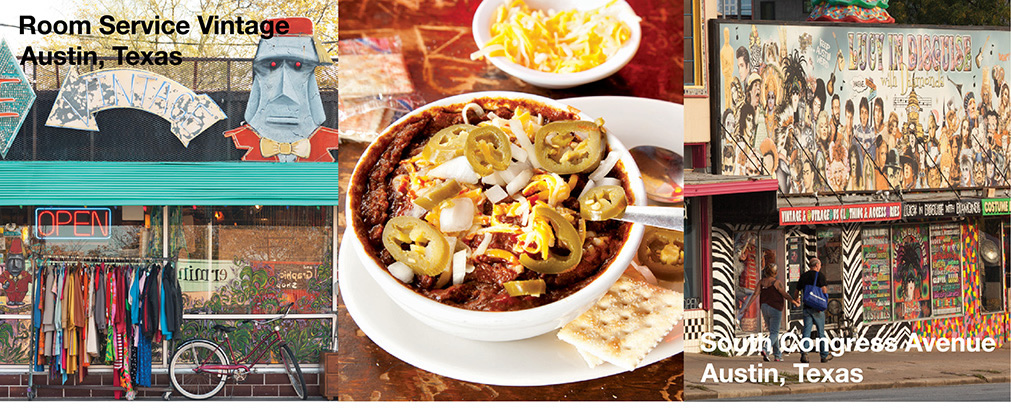
Austin has more dollars in local circulation today than it used to, but it retains a distinctively hippie feeling.

Dallas, of course, was where President John F. Kennedy was assassinated on November 22, 1963. A somber X painted on Elm Street marks the spot where at least one bullet struck the president as his motorcade rolled by. Conspiracy theorists still take up residence and talk up visitors on the grassy knoll near the Texas School Book Depository, now the Dallas County Administration Building. The top two floors house The Sixth Floor Museum, which features historical exhibits and public programming.
And the Texas Theatre, where convicted assassin Lee Harvey Oswald was arrested, still stands on West Jefferson Boulevard. The venue’s life before and after the tragedy mirrors that of Dallas itself.
The Texas Theatre was a big deal when it opened in 1931. The largest in Dallas and the first in the state to have air-conditioning, the theater was fitted with state-of-the-art sound and projection equipment for its time and had all kinds of architectural flourishes: towers and campaniles, trompe l’oeil stars and clouds on the ceilings, and, outside, an enormous neon sign spelling out T-E-X-A-S.
The depression that the city sank into after the Kennedy assassination affected the theater: The facade and many of the interior details were covered up with Spanish-style stucco. It closed due to poor ticket sales in 1989. Director Oliver Stone restored the exterior to its former appearance for his movie JFK. The interior was renovated in early 2005.
Today it’s a bar, a theater showing mostly independent movies, and a must-visit for students of American history.

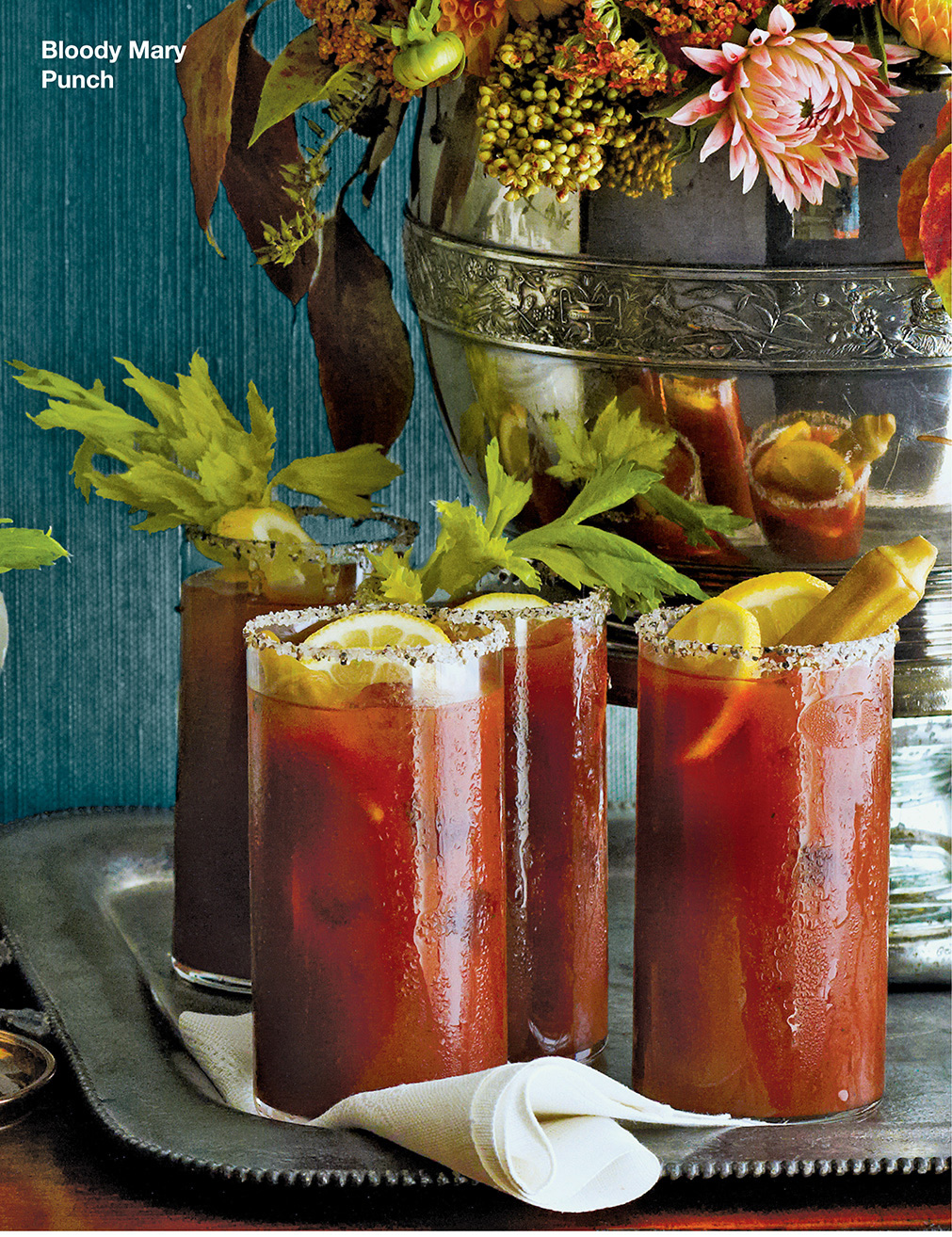
Bloody Mary Punch
Instead of stirring all the ingredients together, you can serve optional shots of vodka on the side and let guests add it or not, depending on their preference.
Makes 1 1/2 qt. Hands-On Time 5 min. Total Time 5 min.
1 (46-oz.) container low-sodium vegetable juice, chilled*
1 Tbsp. freshly ground black pepper
3 Tbsp. fresh lime juice
1 Tbsp. hot sauce
1 Tbsp. Worcestershire sauce
1/2 tsp. Old Bay seasoning
1/2 cup vodka (optional), chilled
Celery sticks (optional)
Garnishes: pickled okra, lemon slices
1. Combine vegetable juice, next 5 ingredients, and, if desired, vodka in a punch bowl or a pitcher. Serve over ice in glasses with celery sticks, if desired.
Note: We tested with V8 Low Sodium 100% Vegetable Juice.

Meet Choreographer
Judy Trammell
A former squad member herself, Trammell is a Texas native who studied jazz, tap, drill team, and pom-pom routines as a child and worked her way up to running the routines for the international phenomenon the squad is today. If you’ve watched a Cowboys game in the past few decades, chances are that Trammell choreographed the halftime show, plus the sideline routines and pregame dances. She has been involved, in one way or another, with the squad since 1980.
She also appears on the CMT network show Dallas Cowboys Cheerleaders: Making the Team, now in its eighth season. Viewers see an ever-poised Trammell as she judges potential cheerleaders on their grace, style, dance, and performance abilities.
Though the cheerleading uniform is famously unforgiving, Trammell is known among her family and friends for her delicious down-home cooking. (Don’t worry, Judy. We won’t tell ’em it’s healthy.)

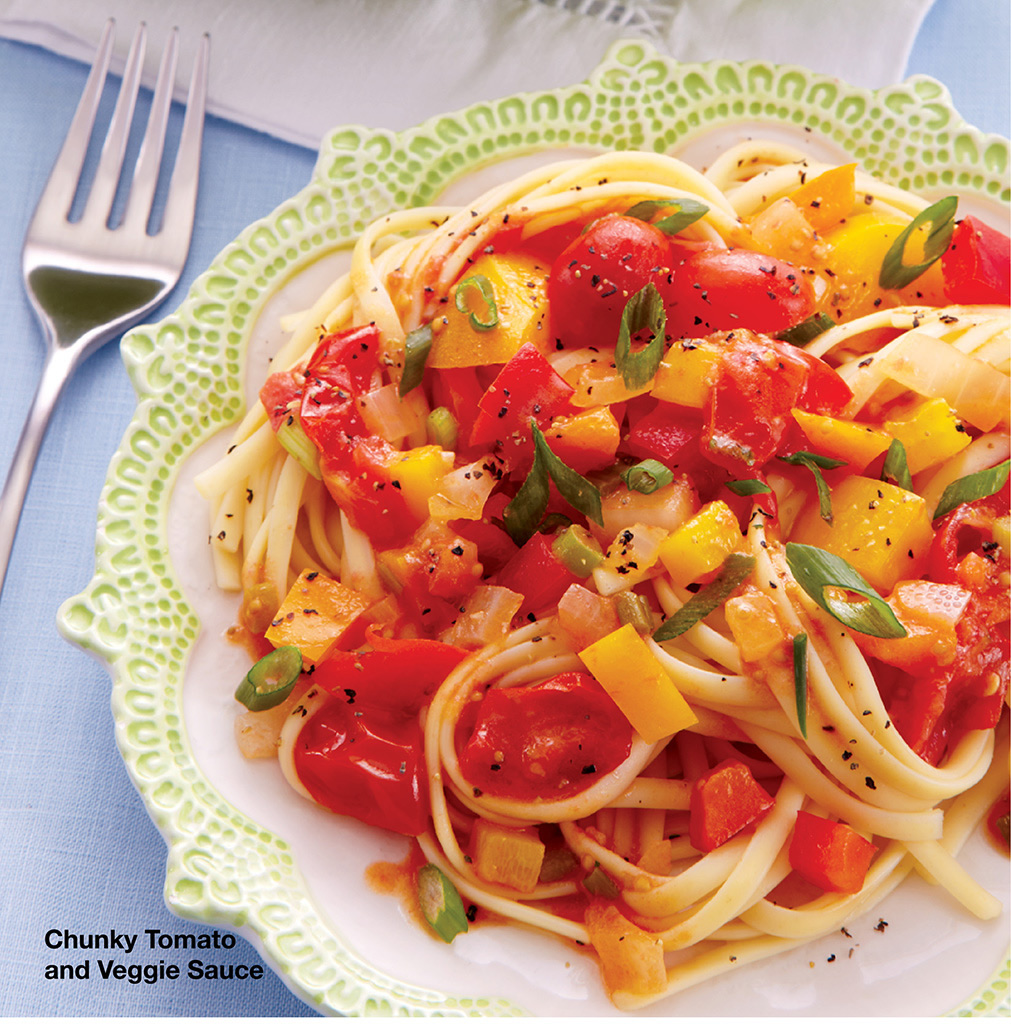
“I use this to top my favorite pasta. And sometimes I like it with a little grilled tilapia, too. I put a fillet with chunky sauce inside a foil pouch, place it on a preheated medium-high grill, cook it until the fish is flaky, and finish it with a squeeze of lemon.” —Judy Trammell
Chunky Tomato and Veggie Sauce
Makes 7 to 8 cups Hands-On Time 15 min. Total Time 45 min.
3 (10-oz.) package sweet red grape tomatoes
2 tsp. minced garlic
1/4 cup extra virgin olive oil
1/4 cup butter (optional: you can omit if you’re really trying to be healthy)
1 white onion, chopped
1 bunch green onions, chopped with some of the greens
1 yellow bell pepper, chopped
1 red bell pepper, chopped
1 orange bell pepper, chopped
1/2 tsp. table salt
1 tsp. black pepper
1. Cut tomatoes in quarters, and cook over medium heat in a large sauté pan with the garlic, olive oil, and butter about 5 minutes. Add remaining ingredients, and sauté to your liking. (I like mine crunchy with the vegetables almost raw, which takes the sauce about 5 more minutes. If you like yours softer, cover and simmer the sauce for about 30 minutes.)
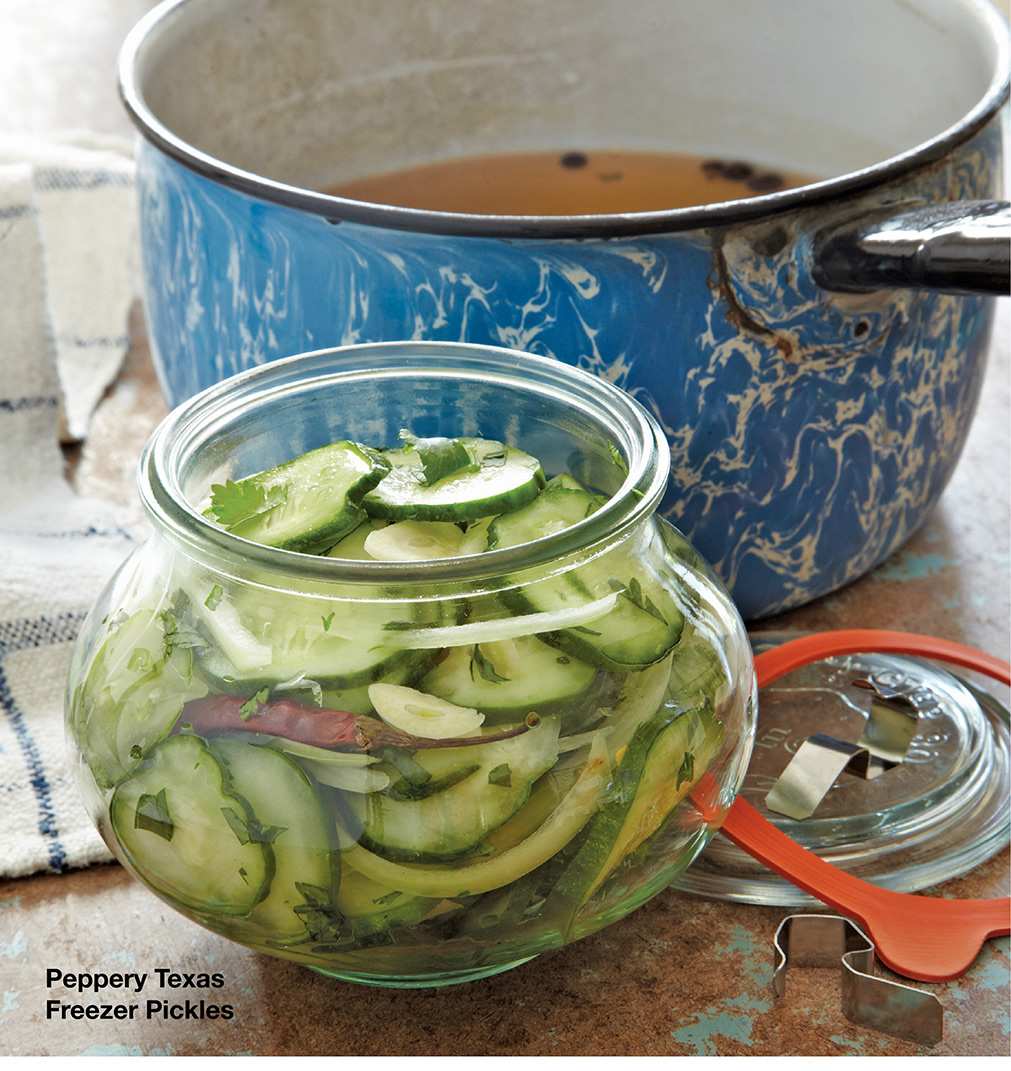
Peppery Texas Freezer Pickles
This easy pickle starts in the microwave, moves to the fridge, and finishes in the freezer so there’s no heating up your kitchen—especially nice in Texas.
Makes 3 qt. Hands-On Time 15 min. Total Time 20 min., plus 2 1⁄2 days for chilling and freezing
2 lb. pickling cucumbers, sliced
1 cup chopped fresh cilantro
6 small dried red chile peppers
4 garlic cloves, thinly sliced
1 large sweet onion, sliced
3 cups white vinegar (5% acidity)
1/3 cup sugar
2 Tbsp. canning-and-pickling salt
1 Tbsp. pickling spices
1. Place first 5 ingredients in a large glass or plastic bowl.
2. Combine vinegar, 1 cup water, sugar, and next 2 ingredients in a large glass measuring cup. Microwave at HIGH 3 minutes; remove from microwave, and stir until sugar dissolves. Pour hot mixture evenly over cucumber mixture. Cover and chill 48 hours.
3. Spoon evenly into 1-qt. canning jars or freezer containers, leaving 1⁄2 inch of room at the top; seal, label, and freeze 8 hours or up to 6 months. Thaw in refrigerator before serving; use thawed pickles within 1 week.

Beef Fajitas with Pico de Gallo
Makes 6 servings Hands-On Time 15 min. Total Time 8 hours, 15 min.
1 (8-oz.) bottle zesty Italian dressing
3 Tbsp. fajita seasoning
2 (1-lb.) flank steaks
12 (6-inch) flour tortillas, warmed
Shredded Cheddar cheese
Garnishes: lime wedges, chopped fresh cilantro sprigs
1. Combine Italian dressing and fajita seasoning in a shallow dish or zip-top plastic bag; add steak. Cover or seal, and chill 8 hours, turning occasionally. Remove steak from marinade, discarding marinade.
2. Preheat grill to 350° to 400° (medium-high) heat. Grill steaks, covered with grill lid, for 8 minutes; turn and grill 5 more minutes (medium-rare) or to desired degree of doneness.
3. Remove steaks, and let stand 5 minutes. Cut steaks diagonally across the grain into very thin slices, and serve with tortillas, cheese, and Pico de Gallo.
Note: If using a two-sided contact indoor electric grill, preheat according to manufacturer’s instructions on HIGH. Place steaks on grill rack, close lid, and grill 10 minutes (medium-rare) or to desired degree of doneness. Proceed as directed in Step 3.
1 pt. grape tomatoes, chopped
1 green bell pepper, chopped
1 red bell pepper, chopped
1 avocado, peeled and chopped
1/2 medium-size red onion, chopped
1/2 cup chopped fresh cilantro
1 garlic clove, pressed
3/4 tsp. table salt
1/2 tsp. ground cumin
1/2 tsp. lime rind zest
1/4 cup fresh lime juice
1. Stir together all ingredients; cover and chill 1 hour.
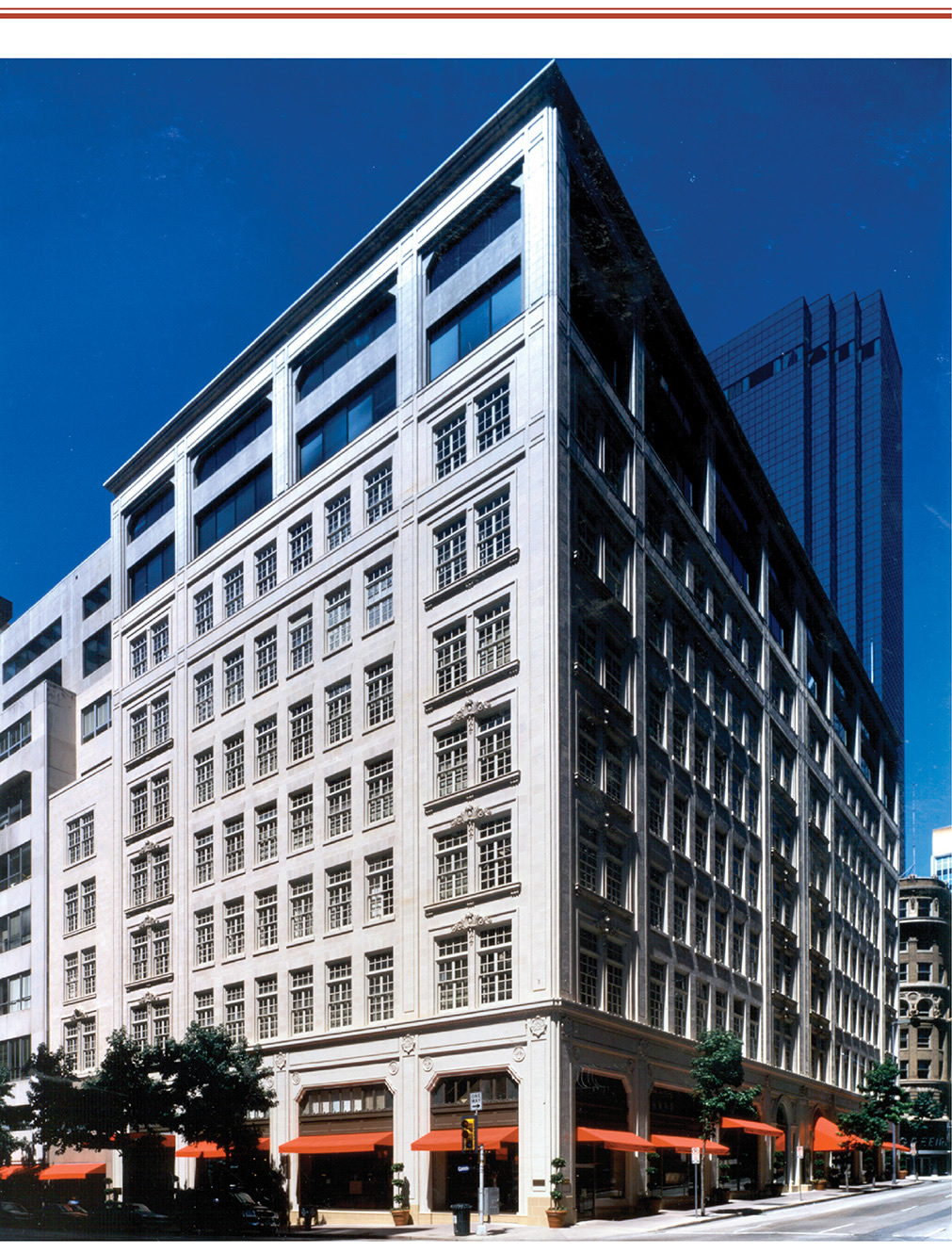
Shop at
Neiman Marcus
Like a Local
Herbert Marcus (along with his sister Carrie and brother-in-law Abraham Lincoln “Al” Neiman) opened Neiman Marcus in 1907. But it wasn’t until Herbert’s son took an interest in the store that it began to acquire its international reputation for luxury. Stanley Marcus, who began working there as a sales clerk in 1926, was the real visionary.
He brilliantly combed local events (he held weekly fashion shows in the flagship store), was one of the first and only local retailers to advertise in national fashion magazines, and, most important, he understood his local clients. Marcus knew that newly minted oil barons were insecure about their tastes. He emphasized quality, luxury, and rarity to win and keep their business.
Though Stanley died in 2002 and the store was sold long ago to a department store conglomerate, Neiman Marcus maintains Stanley’s legacy, and shopping there is as luxurious an event as ever. The flagship downtown store is known for its trunk shows of famous designers, its made-to-measure men’s suits, and its elegant restaurant, The Zodiac, a mecca for ladies who lunch.

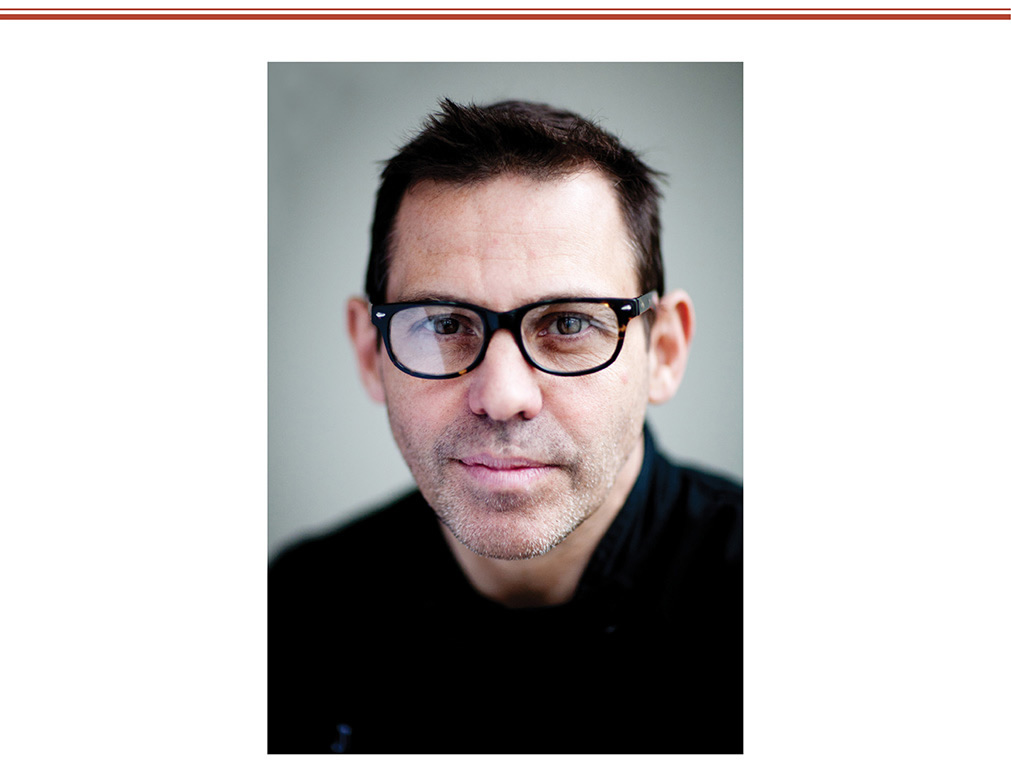
Meet Chef
John Tesar
He’s a native New Yorker who came up cooking alongside Anthony Bourdain and Rick Moonen, two of the country’s most outspoken chefs. Not much gets to him—not even D Magazine reporting “rumors about tantrums in the kitchen, pan throwing, sleeping with socialites, and day drinking.”
“I’m the most provocative chef in Dallas,” he eagerly acknowledges, and he probably is. What brought him to Dallas in 2007 was a job cooking at the venerable Rosewood Mansion on Turtle Creek, a legendary restaurant that was in need of a face-lift. Tesar made the food much, much better, though he and the management reportedly didn’t get along.
Now he’s got new partners and his own joint, Spoon Bar & Kitchen. Tesar is admittedly temperamental, short-tempered, and full of passion. He is also incredibly creative. And right now diners who come to Spoon Bar & Kitchen in Dallas are enjoying everything about him—even the controversy.

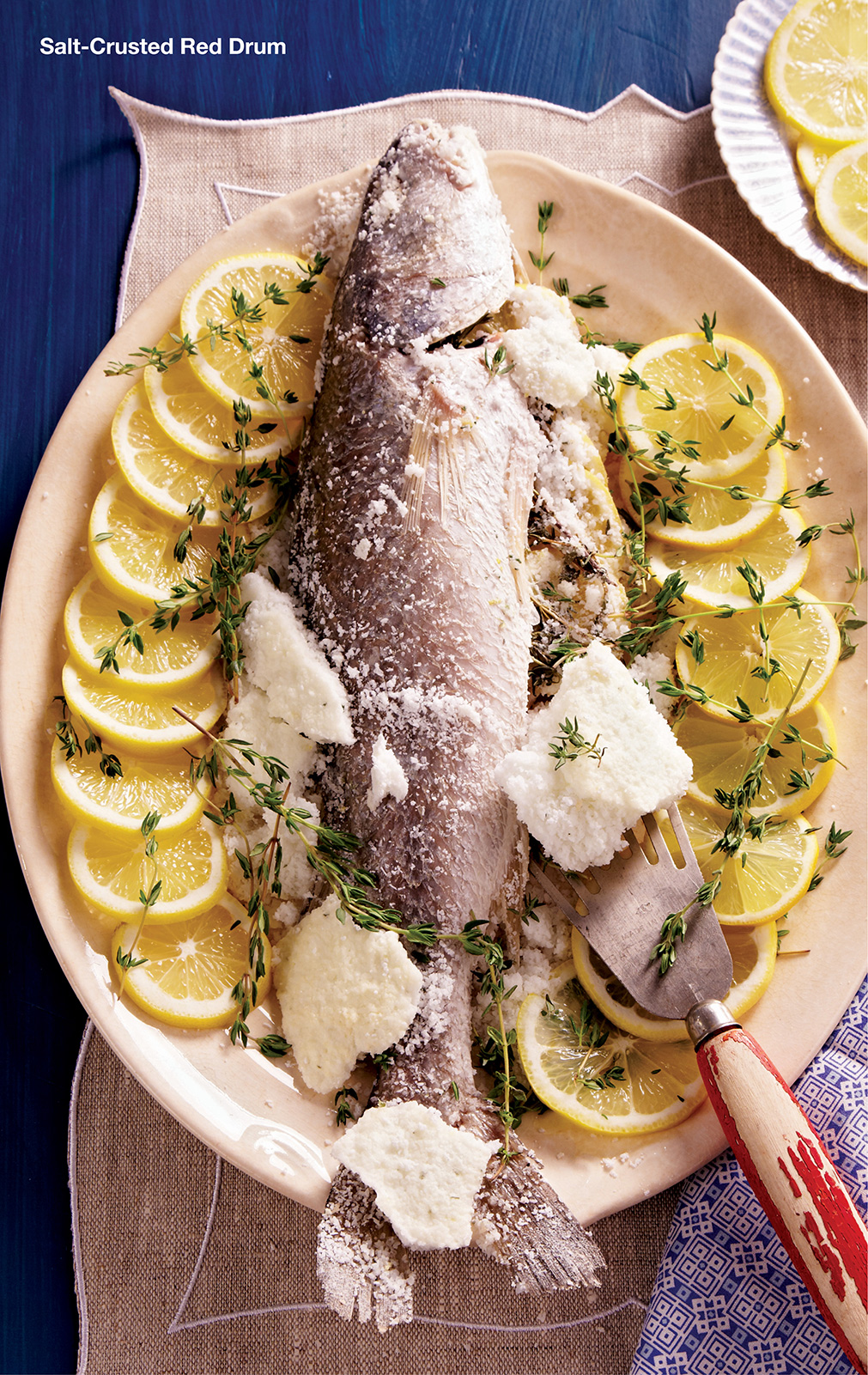
“I love to cook seafood. There’s no one particular dish. For me it’s all about creativity—being precise, and being creative.” —John Tesar
Salt-Crusted Red Drum
Makes 4 servings Hands-On Time 15 min. Total Time 50 min.
1 bunch fresh thyme sprigs, divided
1 1/2 tsp. lemon zest
3 Tbsp. fresh lemon juice
4 fresh bay leaves, coarsely snipped using scissors
3 garlic cloves, smashed
9 egg whites
8 cups kosher salt
1 lemon, sliced into thin rounds
1 (3-lb.) whole red drum (redfish), cleaned*
High-quality olive oil
1. Preheat oven to 450°. Pick the leaves from half of the thyme sprigs. Combine lemon zest, lemon juice, thyme leaves, bay leaves, and garlic in a food processor; pulse until it becomes a coarse paste. Add egg whites, and process until foamy and frothy. In a large bowl, combine egg white mixture and salt; mix until it becomes a moist paste.
2. Place half of the lemon slices and whole thyme sprigs in the cavity of the fish. Place a little less than half of the salt mixture on a baking sheet; lay the fish on top. Pack the remaining salt mixture on top of the fish to completely encase it, pressing the mixture firmly against the fish to create a crust. Bake at 450° for 25 minutes. Remove from oven, and let stand 10 minutes.
3. Crack open the salt crust, and brush the excess salt from the fish. Remove the top fillet; pull the spine out, and remove the bottom fillet. Drizzle with olive oil, and serve with remaining lemon slices and thyme sprigs.
*Note: If you can’t find red drum, you can substitute red snapper.
Spicy Slow-Cooker Beef Chili
What’s more Texan than a beefy, no-bean chili?
Makes 8 cups Hands-On Time 15 min. Total Time 3 hours, 25 min.
1 (10 1/2-oz.) can condensed beef broth
4 dried ancho chile peppers, stemmed and seeded
2 Tbsp. all-purpose flour
1 1/2 tsp. ground cumin
1 tsp. table salt
1 (2-lb.) London broil, cut into 1/2-inch cubes
2 onions, chopped
4 garlic cloves, minced
1 1/2 tsp. dried oregano
1 (16-oz.) bottle dark beer
Halved jalapeño peppers
Sour cream
Refrigerated salsa
Saltine crackers
1. Microwave broth in a microwave-safe bowl at HIGH 2 to 3 minutes or until simmering. Place ancho chile peppers in a blender. Pour hot broth over peppers; let stand 10 minutes. Holding lid down with a towel, process peppers and broth until smooth.
2. Sprinkle flour, cumin, and salt over London broil. Place beef in a 4-qt. slow cooker. Add onion, garlic, oregano, beer, 1 cup water, and pepper mixture. Cover and cook on HIGH 3 to 4 hours (or on LOW 5 to 6 hours) or until beef is tender.
3. Top with halved jalapeño peppers, sour cream, and refrigerated salsa. Serve with saltine crackers.
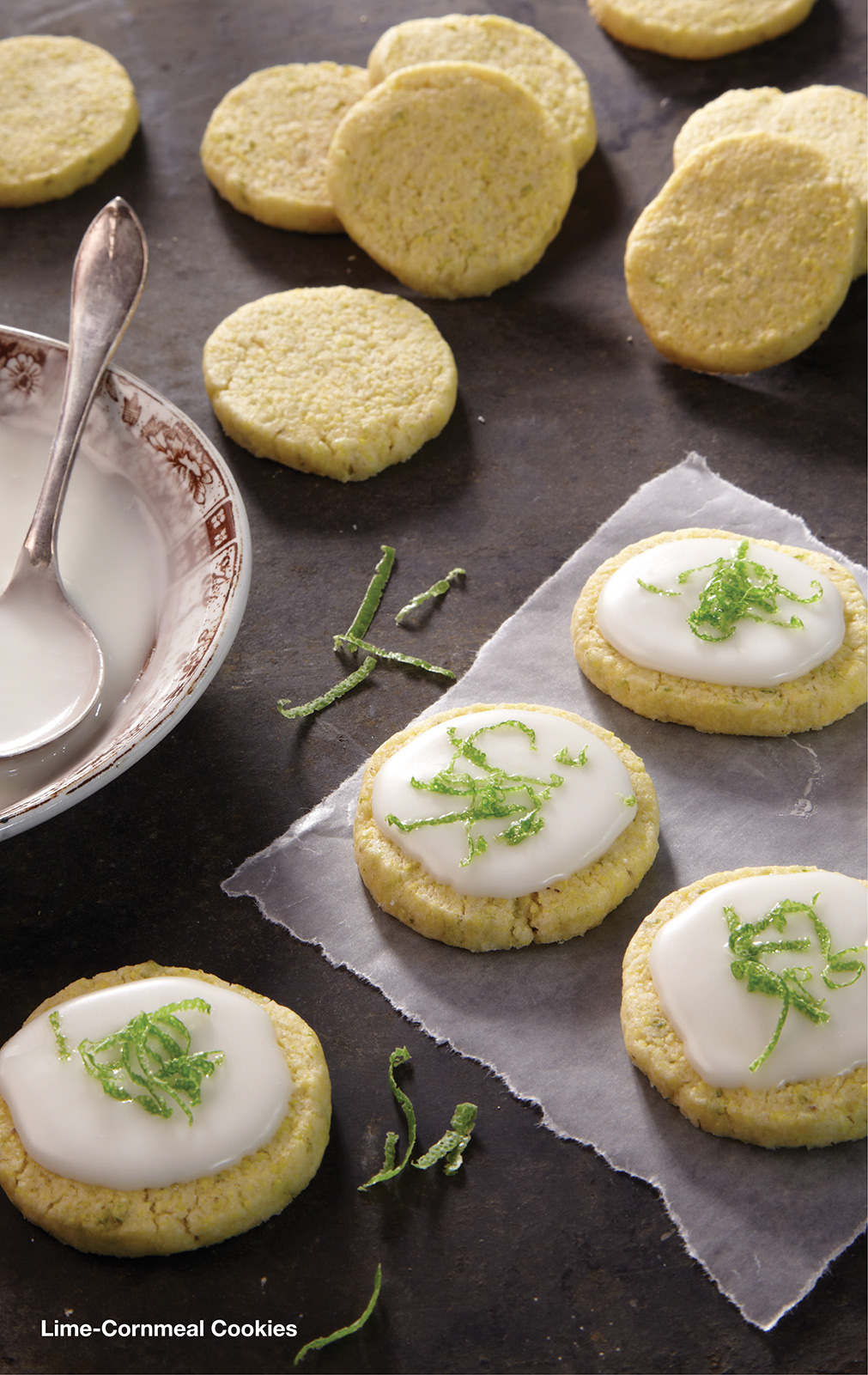
~ A Recipe from a Local ~
Lime-Cornmeal Cookies
Don’t skip the chill time or the dough will be too soft to shape into a log.
Makes about 2 1/2 dozen Hands-On Time 20 min. Total Time 10 hours
1 1/4 cups all-purpose flour
1/2 cup plain yellow cornmeal
1/2 cup butter, softened
1/2 cup sugar
1 large egg
1 Tbsp. lime zest, plus more for garnish
1 Tbsp. fresh lime juice
1/2 tsp. vanilla extract
Wax paper
1 cup powdered sugar
2 Tbsp. milk
1. Combine flour and cornmeal. Beat butter and sugar at medium speed with an electric mixer until light and fluffy. Add egg and next 3 ingredients, beating until blended. Gradually add flour mixture, beating just until blended after each addition. Cover and chill dough 1 hour.
2. Shape dough into a 12-inch log using wax paper. Wrap tightly in plastic wrap, and chill 8 hours.
3. Preheat oven to 375°. Cut log into 1/4-inch-thick slices. Place 1 inch apart on ungreased baking sheets. Bake 12 minutes or until set. Transfer to wire racks; cool completely (about 15 minutes). Stir together powdered sugar and milk in a small bowl; drizzle on cookies.
Executive Chef-Owner Lanny P. Lancarte II
Lanny’s Alta Cocina Mexicana
Fort Worth, Texas
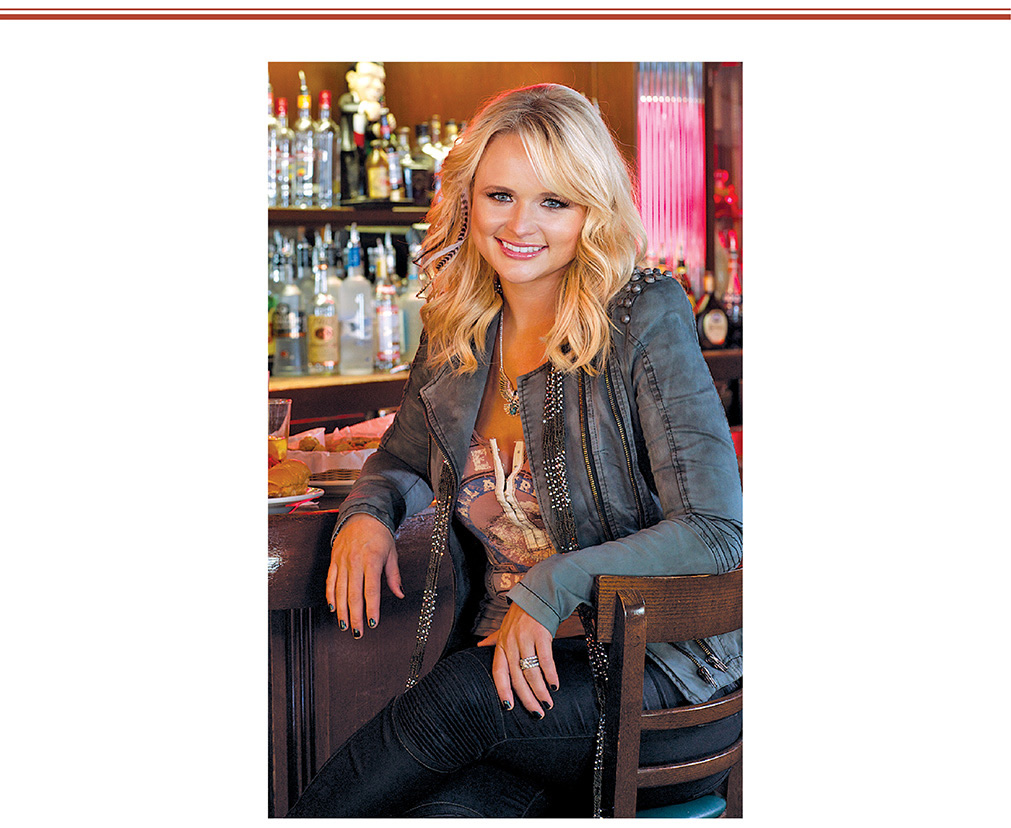
Meet Country Singer
Miranda Lambert
And Miranda Lambert is something else: A gorgeous blonde babe with a tough-talkin’, pistol-packin’, take-no-prisoners persona. Her first three albums went platinum, she’s been the Country Music Association’s female vocalist of the year, and she is a tireless tour performer around the country. She got her start as a runner-up on the TV show Nashville Star and, with her trademark feisty determination, made it onto the country music scene.
Along the way, she acquired an equally charismatic performer for a husband, one Mr. Blake Shelton, who has turned her into an Oklahoma girl. “I’m from Texas,” Lambert says, “Just as much as I love Texas, I now love Oklahoma.”

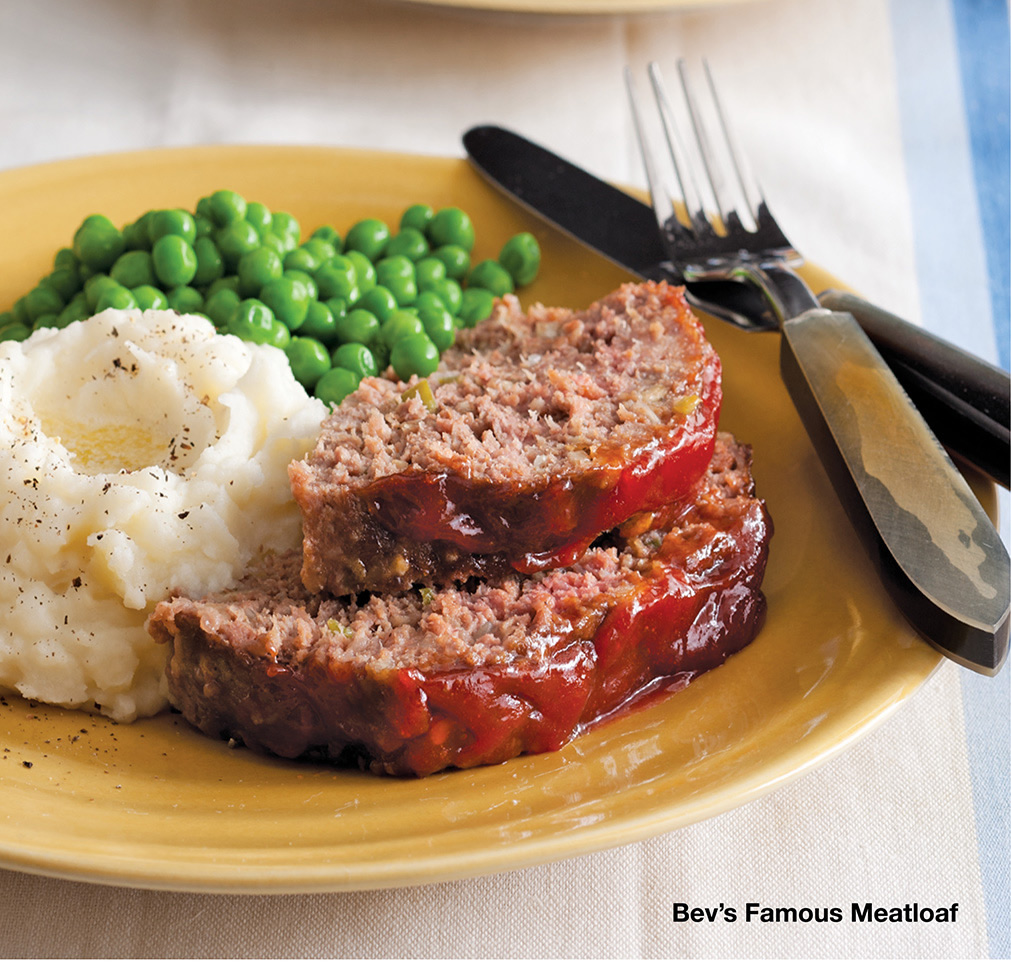
“My mom, Bev, and I have cooked together as far back as she could bring a stool to the kitchen counter, and her meatloaf has always been my favorite recipe. It’s been the choice ‘birthday dish’ for me and my brother since we were little.” —Miranda Lambert
Bev’s Famous Meatloaf
Makes 10 servings Hands-On Time 25 min. Total Time 2 hours
2 lb. lean ground beef
1 lb. ground pork sausage
18 saltine crackers, crushed
1/2 green bell pepper, diced
1/2 onion, finely chopped
2 large eggs, lightly beaten
1 Tbsp. Worcestershire sauce
1 tsp. yellow mustard
1/2 cup firmly packed brown sugar, divided
1/2 cup ketchup
1. Preheat oven to 350°. Combine first 8 ingredients and 1/4 cup brown sugar in a medium bowl just until blended. Place mixture in a lightly greased 11- x 7-inch baking dish, and shape into a 10- x 5-inch loaf.
2. Bake at 350° for 1 hour. Remove from oven, and drain. Stir together ketchup and remaining 1/4 cup brown sugar; pour over meatloaf. Bake 15 more minutes or until a meat thermometer inserted into thickest portion registers 160°. Remove from oven; let stand 20 minutes. Remove from baking dish before slicing.
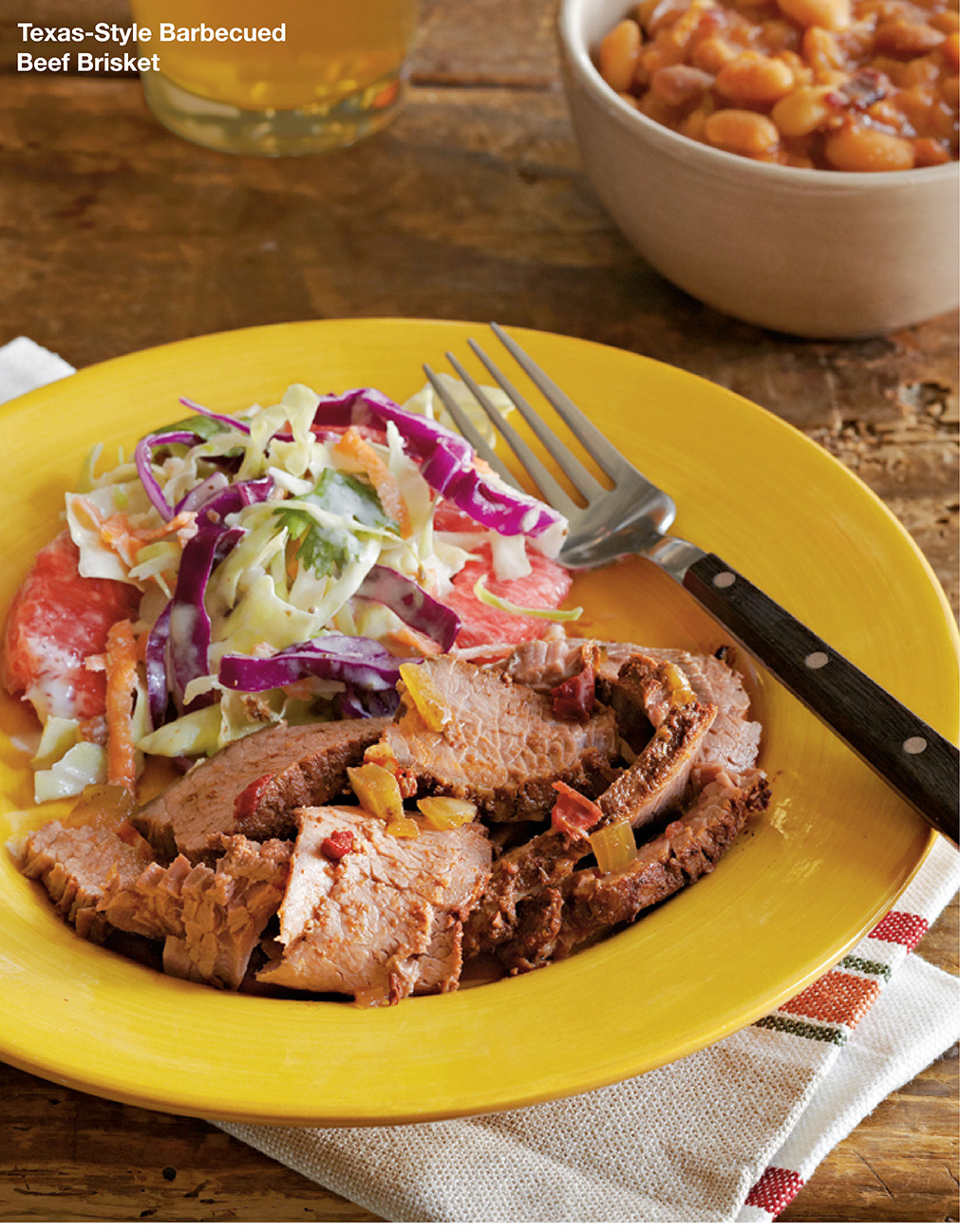
Texas-Style Barbecued Beef Brisket
Serve this with your favorite slaw, and sop up the pan juices with Texas toast.
Makes 4 to 6 servings Hands-On Time 20 min. Total Time 7 hours, 40 min.
1 large sweet onion, sliced
3 garlic cloves, chopped
1 Tbsp. chili powder
1 Tbsp. jarred beef soup base
1 Tbsp. Worcestershire sauce
1 tsp. ground cumin
1/2 tsp. black pepper
1 1/2 tsp. hickory liquid smoke
1 (2- to 3-lb.) beef brisket flat, trimmed
1/4 cup beer
3 Tbsp. bottled chili sauce
1. Lightly grease a 6-qt. slow cooker; add onion and garlic. Stir together chili powder and next 5 ingredients. Rub over brisket; place brisket over onion mixture in slow cooker.
2. Whisk together beer and chili sauce. Slowly pour mixture around brisket (to avoid removing spices from brisket).
3. Cover and cook on LOW 7 to 8 hours (or on HIGH 4 to 5 hours) or until fork-tender. Uncover; let stand in slow cooker 20 minutes.
4. Remove brisket from slow cooker; cut brisket across the grain into thin slices. Return brisket to slow cooker; spoon pan juices over meat.
Note: We tested with Heinz Chili Sauce.
~ A Recipe from a Local ~
Chipotle Smashed Sweet Potatoes
About 200 miles southeast of El Paso, little Marfa is the very definition of “unusual.” It’s where the Wild West meets the international food and art community. Artist and self-taught chef Maiya Keck settled in this quaint-but-quirky Texas oasis. Surrounded by three mountain ranges, Marfa’s unlikely population of fourth-generation ranchers, renowned artists, and tourists who never left enjoys some of the best food this side of the border.
Makes 8 servings Hands-On Time 15 min. Total Time 30 min.
3 lb. fresh sweet potatoes, peeled and chopped
1/2 cup butter, cut into pieces
1 to 2 Tbsp. minced canned chipotle peppers in adobo sauce
1/4 cup heavy cream
1. Bring sweet potatoes and salted water to cover to a boil in a Dutch oven over high heat. Reduce heat to medium, and simmer 10 to 15 minutes or until tender. Drain, reserving 1/2 cup water.
2. Return potatoes to Dutch oven. Add butter, minced peppers, and cream; mash with a potato masher, adding reserved water, a little at a time, for desired consistency. Season with salt to taste. Transfer to a serving bowl.
Chef Maiya Keck, Maiya’s
Marfa, Texas

Start with land area: Houston’s 634 square miles are big enough to contain the entire New York City metropolitan area.
America’s fourth-most-populous city also has one of its largest museum districts: 18 venues within walking distance of one another. These include the Children’s Museum of Houston, the country’s most-visited youth museum; the Rothko Chapel, a cathedral as well as a museum that GQ calls one of the “most mind-blowing, energizing, unorthodox and flat-out-cool places to experience art in America”; and the Health Museum, an educational institution with a giant human body exhibit that includes a 22-foot-long backbone and ceiling-to-floor ribs.
Fourteen major institutions of higher education call Houston home, including Rice University, Baylor University, and the University of Houston (and its prestigious Thurgood Marshall School of Law). Its Texas Medical Center is the site of the most heart transplants each year in the world (and also the first successful human heart transplant in 1968).
There are more than 8,000 restaurants, 50,632 acres of park space, and 90 languages spoken in Houston. And “Houston” was the first word spoken in space, when astronaut Neil Armstrong uttered the words, “Houston, Tranquility Base here. The Eagle has landed.”
No fewer than five major fashion brands have launched here, including the high-end cosmetics giant Laura Mercier and the Jackie O-favorite footwear brand Bernardo. At least a dozen blockbuster movies have been filmed here, including Terms of Endearment and the indie favorite Rushmore.

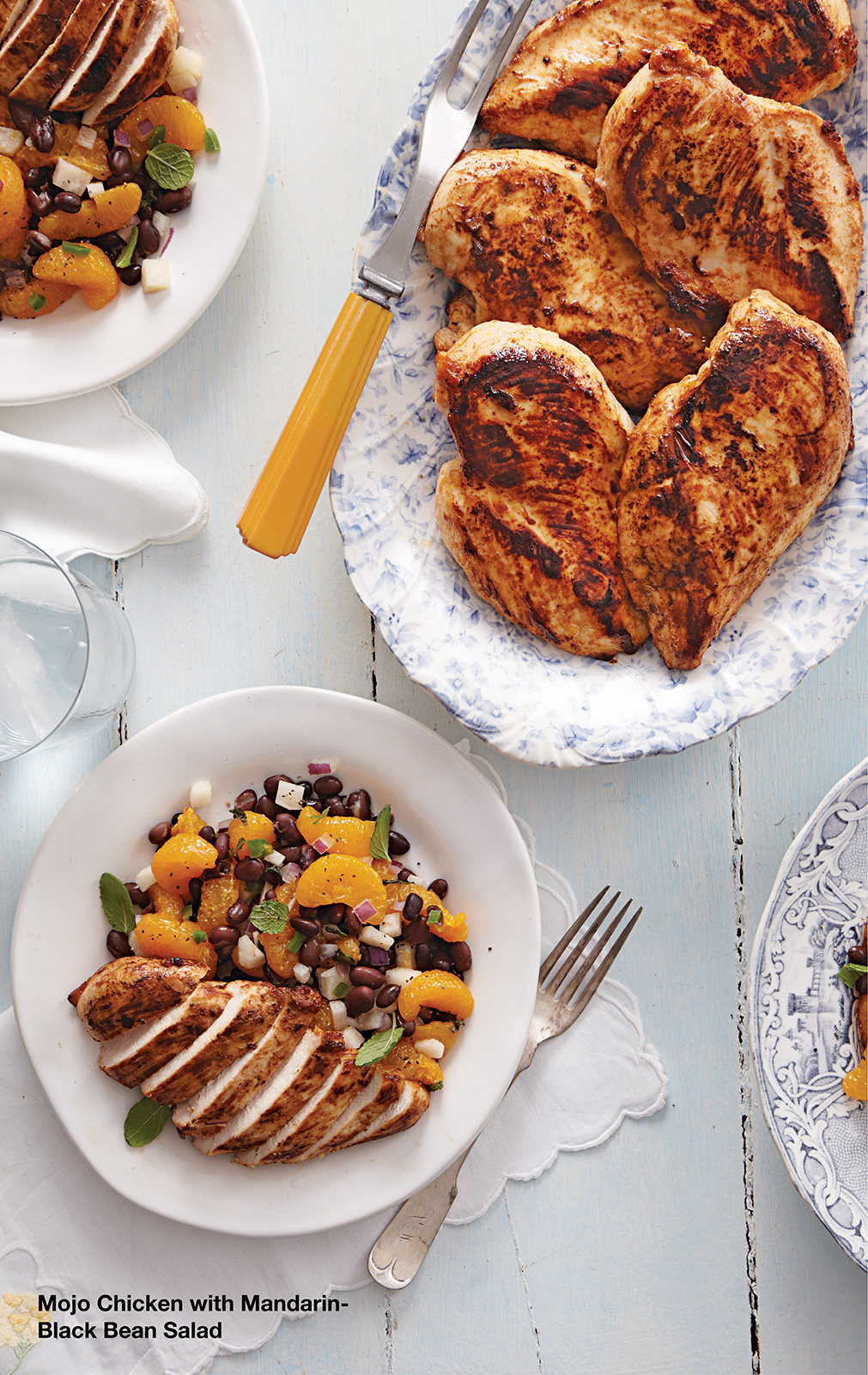
~ A Recipe from a Local ~
Mojo Chicken with Mandarin-Black Bean Salad
Mix up the Mandarin-Black Bean Salad and take a siesta while the chicken marinates.
Makes 4 servings Hands-On Time 10 min. Total Time 45 min.
1/4 cup fresh orange juice
1/4 cup fresh lime juice
2 garlic cloves, minced
1 tsp. ground cumin
1/2 tsp. dried oregano, crushed
1/2 tsp. paprika
1/2 tsp. table salt
4 (5-oz.) boneless, skinless chicken breasts
Garnish: fresh mint sprigs
1. Combine first 7 ingredients in a zip-top freezer bag or shallow dish; add chicken. Cover or seal, and let stand 20 minutes. Remove chicken from marinade, reserving marinade. Pat chicken dry with paper towels.
2. Lightly grease a large nonstick skillet; heat skillet over medium-high heat. Add chicken, and cook 4 to 5 minutes on each side or until desired degree of doneness. Remove chicken from skillet, and keep warm.
3. Wipe skillet clean. Add reserved marinade, and bring to a boil. Boil 2 minutes, stirring often.
4. Cut chicken diagonally into 1/2-inch-thick slices. Spoon Mandarin-Black Bean Salad in center of 4 serving plates. Arrange chicken slices around salad, and drizzle chicken evenly with warm marinade.
2 cups mandarin orange segments, well drained
1 cup canned black beans, rinsed and drained
3/4 cup diced jicama
2 Tbsp. chopped red onion
2 Tbsp. seeded, minced jalapeño
2 Tbsp. shredded fresh mint leaves
1/4 tsp. table salt
1. Stir together all ingredients in a large bowl. Let stand until ready to serve, tossing occasionally.
Gloria Duke
Tomball, Texas

~ You've Gotta Try ~
Houston Vietnamese Food
The inevitable happened from there: The Vietnamese set up shrimp shacks on the port and began making their way into area food markets and restaurants. Along with them came some of their signature dishes—a few of which Texans have adopted and enjoyed enough to make staples. In Texas, you’ll find good pho, the Vietnamese beef noodle soup, not to mention the spicy, crunchy, cilantro-topped banh mi sandwiches that are now part of the national zeitgeist (pork, pickles, peppers, and pâté on a French baguette—thank you, colonization).
The single most popular dish, though, has to be bo luc lac, beef tenderloin chunks “shaken” in a hot wok until medium-rare (and thus sometimes referred to on restaurant menus as “shaken beef” or “rock’n’roll beef”) and served over salad greens dressed with a rice vinegar and shallot vinaigrette.
At its best, the dish is tangy, sweet, and toothsome—simultaneously elegant enough for ladies who lunch and unique enough for college students who love ethnic food.


Vietnamese Barbecue Tacos
Vibrant Vietnamese and Tex-Mex flavors meet in these Houston-inspired tacos.
Makes 8 servings Hands-On Time 30 min. Total Time 8 hours, 50 min.
3 beef strip steaks (about 2 1/2 lb.)
1/4 cup fish sauce
1/4 cup rice wine vinegar
2 Tbsp. grated fresh ginger
3 garlic cloves, minced
2 Tbsp. sugar
2 Tbsp. honey
1 Tbsp. sesame oil
1 tsp. freshly ground black pepper
1/2 medium-size red onion, sliced
8 (8-inch) soft taco-size flour tortillas, warmed
Toppings: thinly sliced red cabbage, matchstick carrots, thinly sliced red onion, chopped fresh cilantro, chopped fresh mint, cucumber slices
1. Place steaks in a large zip-top plastic freezer bag. Whisk together fish sauce and next 7 ingredients. Stir in red onion, and pour mixture over steaks in freezer bag. Seal and chill 8 to 24 hours, turning once.
2. Preheat grill to 350° to 400° (medium-high) heat. Remove steaks from marinade, discarding marinade.
3. Grill steaks 7 to 8 minutes on each side or to desired degree of doneness, turning every 3 to 5 minutes. Cover loosely with aluminum foil, and let stand 10 minutes.
4. Cut steaks diagonally across the grain into thin strips, and serve in warm flour tortillas with Vietnamese Dipping Sauce and desired toppings.
Vietnamese Dipping Sauce
Serve this versatile sauce with Vietnamese Barbecue Tacos or rice rolls, or use it as a salad dressing.
Makes 1 cup Hands-On Time 5 min. Total Time 5 min.
1/4 cup fish sauce
1/4 cup white vinegar
3 Tbsp. sugar
2 Tbsp. fresh lime juice
2 garlic cloves, minced
1 serrano pepper or Thai chile pepper, sliced and seeded
1. Stir together 1/2 cup water, fish sauce, vinegar, sugar, lime juice, garlic, and serrano pepper in a medium bowl. Refrigerate in an airtight container up to 1 week.
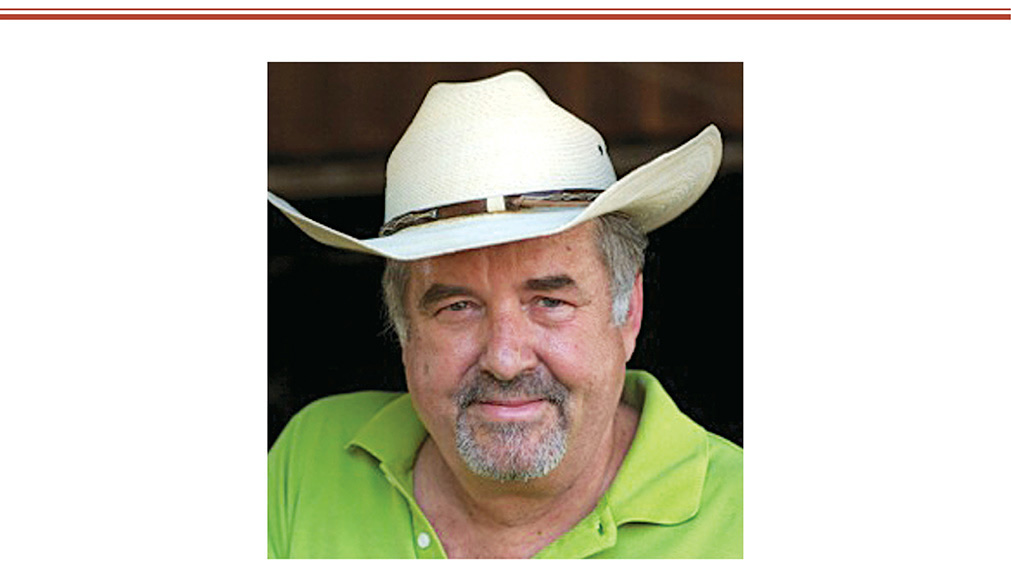
Meet Journalist
Robb Walsh
A journalist invested in exploring every nook and cranny of his home state’s food traditions, Walsh first caught the public eye as a reporter for the Austin Chronicle when he founded the paper’s Hot Sauce Festival in 1990. Billed as the world’s largest such festival and a rollicking good time to be sure, it continues to this day.
Walsh, however, has moved on to meatier pursuits. Now the food editor at Houstonia Magazine, a new city magazine for Houston from the people who publish Portland Monthly and Seattle Met, Walsh is also the founder of Foodways Texas, an organization devoted to chronicling and promoting Texas food culture through oral history projects, books, symposia, and documentary film (and live barbecues, of course).
Along the way, Walsh has won three James Beard Foundation Journalism Awards and written about everything from Dr Pepper bootleggers and Spam luaus to racism in the barbecue world. His six books include Legends of Texas Barbecue, a cookbook filled with stories from pitmasters.

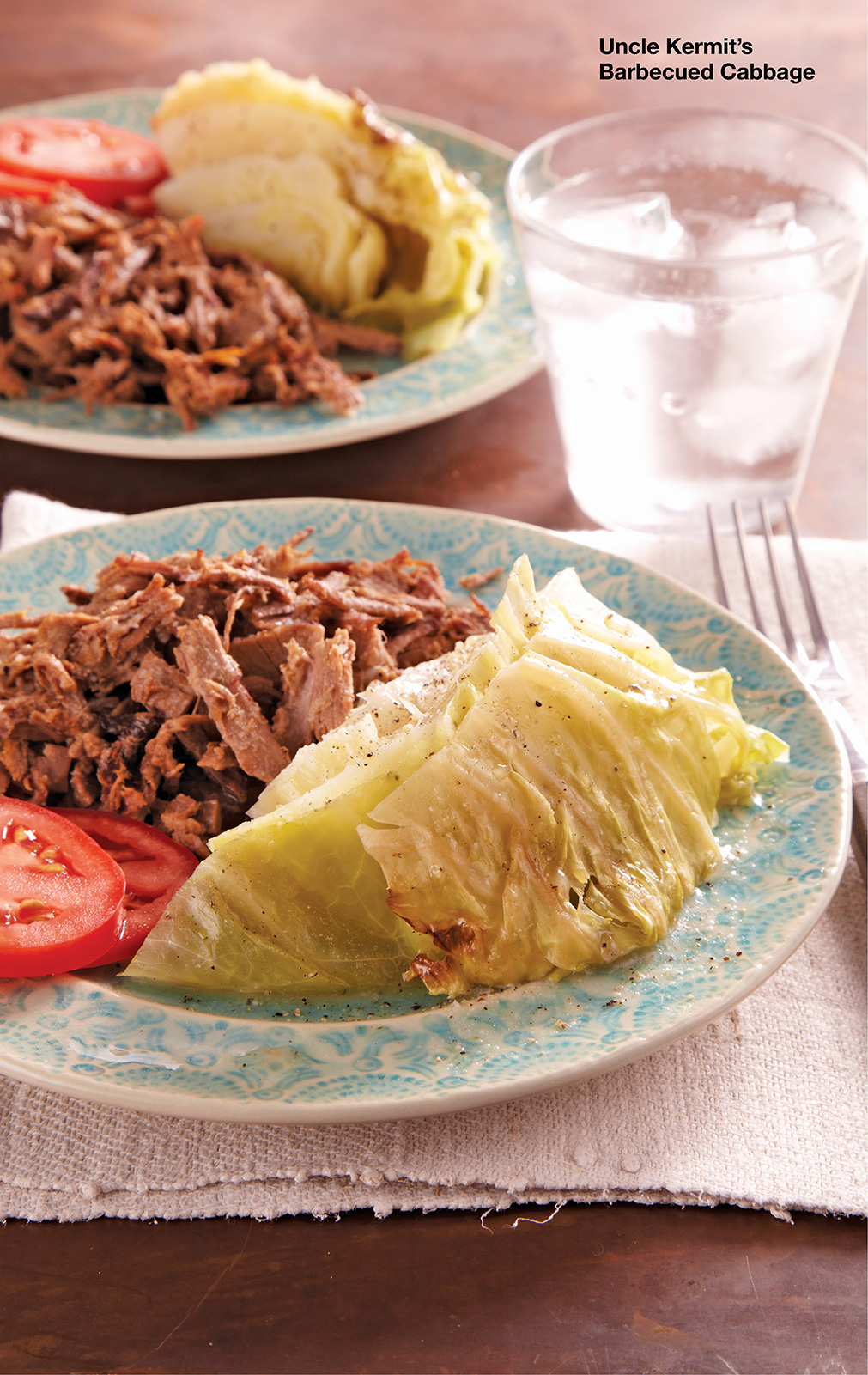
“East Texas barbecue joints tend to be proud of their side dishes, including old Southern classics like turnip greens, okra, fried green tomatoes, and others not seen in other barbecue restaurants.” —Robb Walsh
Uncle Kermit’s Barbecued Cabbage
This recipe traces back to Kermit Sakewitz, the uncle of a barbecue cook-off competitor I met in Taylor, Texas. An old German favorite, it’s a perfect partner for Texas-style smoked brisket or anything else you’re barbecuing. Add it during the final cooking hours, and serve it with the meat.
Makes 6 to 8 servings Hands-On Time 5 min. Total Time 3 hours, 5 min.
5 cups hickory wood chips
1/2 cup butter, softened
1 Tbsp. table salt
1 tsp. onion powder
1 tsp. freshly ground black pepper
1 small head green cabbage (about 3 1/2 lb.)
1. Soak wood chips in water at least 30 minutes. Prepare smoker according to manufacturer’s directions. Bring internal temperature to 225° to 250°, and maintain temperature for 15 to 20 minutes.
2. Combine butter, salt, onion powder, and pepper in a small bowl. Core cabbage, carving out a good-size cavity. Stuff seasoned butter into cavity, then wrap cabbage in heavy-duty aluminum foil. Drain wood chips, and place on coals. Place water pan in smoker, and add water to depth of fill line. Place cabbage in center of upper food rack; cover with smoker lid. Smoke 3 hours or until cabbage is tender, maintaining the temperature inside the smoker between 225° and 250°. Add additional water, charcoal, and wood chips as needed. Unwrap cabbage. Trim away and discard any blackened leaves, butter foam, or spice residue. Cut cabbage into wedges.

But a key part of its allure is that it’s a walkable city with generally awesome weather. San Antonio has an annual average of 300 days of sunshine and an average daily temperature of 70 degrees. It’s got 68 miles of urban hiking and biking trails, and it’s home to B-Cycle, Texas’s first bike-share program. The crown jewel in all of this walking around has got to be the River Walk, which hugs the San Antonio River one story below street level and is often described as an urban sanctuary. Galleries, shops, and public art installations line some sections of it, while others feature tranquil waterfalls.
Also good for a walking tour—and just a short walk away—is The Alamo, a 4.2-acre complex that includes the original Spanish mission where a small band of Texans held out for 13 days against the mighty army of Centralist Mexican General Santa Anna. A group called the Daughters of the Republic of Texas, Inc. manages what remains of the mission: three buildings with Texas Revolution exhibits, plus gardens and a gift shop. Exhibits include an original Bowie knife, Davy Crockett’s buckskin vest, and a flintlock rifle used in the battle.
For thrill-seekers there’s Six Flags Fiesta Texas, a gigantic slice of Americana known as an amusement park. No less fun but definitely more unique is the Schlitterbahn, about 30 miles away in New Braunfels. Routinely listed among the best destinations for kids, it boasts the world’s longest waterpark ride, an attraction that lets you float on inner tubes over rapids, down waterfalls, and atop tall waves.


Guacamole
Fuel a San Antonio stroll with crisp chips and cool, creamy guacamole.
Makes 3 1/2 cups Hands-On Time 10 min. Total Time 40 min.
5 ripe avocados
2 Tbsp. finely chopped red onion
2 Tbsp. fresh lime juice
1/2 medium jalapeño pepper, seeded and chopped
1 garlic clove, pressed
3/4 tsp. table salt
Tortilla chips
1. Cut avocados in half. Scoop pulp into a bowl, and mash with a potato masher or fork until slightly chunky. Stir in chopped red onion and next 4 ingredients.
2. Cover with plastic wrap, allowing wrap to touch mixture, and let stand at room temperature 30 minutes. Serve guacamole with tortilla chips.
For Cilantro Guacamole: Stir in 3 Tbsp. chopped fresh cilantro and an additional 1 Tbsp. lime juice.

Meet Actress
Eva Longoria
You probably know Eva Longoria from her role on the hit TV show Desperate Housewives. You may even know she was Miss Corpus Christi before landing a gig on The Young and the Restless. What you may not know is that she’s one of the country’s 100 most influential Hispanics. So says People, and not for nothing.
She’s profoundly philanthropic, tirelessly promoting causes. Inspired by her sister with Down syndrome, she co-founded Eva’s Heroes, a San Antonio nonprofit that benefits developmentally disabled children. She also produces documentaries such as Harvest, a film exploring the plight of child farm workers.
And then there’s her love of food: She co-owns Latin steakhouses in Las Vegas and Hollywood. Her late Aunt Elsa taught her the joys of preparing food and was, she says, the inspiration for her 2011 cookbook, Eva’s Kitchen.

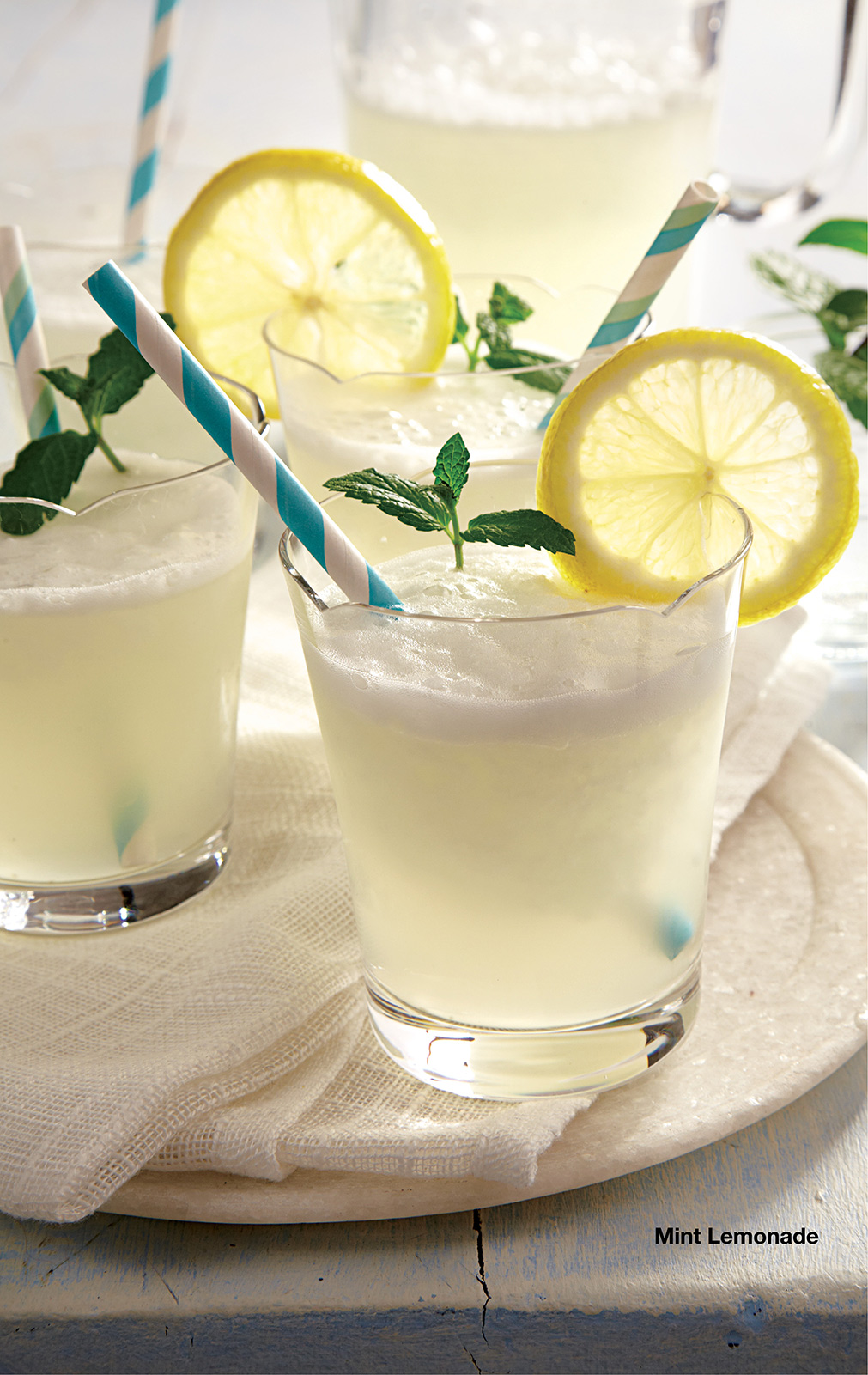
“We had lemon trees and mint all over our ranch when I was a kid. I don’t remember when I tasted the two together for the first time, but since then I’ve never liked lemonade any other way.” —Eva Longoria
Mint Lemonade
For kids or anyone not drinking alcohol, this is a fabulously festive and beautiful nonalcoholic treat. Or add a shot of rum or vodka to each glass, and make a cocktail out of it!
Makes 4 servings Hands-On Time 7 min. Total Time 7 min.
1/2 cup sugar
1/4 cup hot water
1/2 cup fresh lemon juice (about 3 large lemons)
3 cups ice cubes (about 24 large cubes)
12 sprigs of fresh mint, plus 4 more for garnish
1. Place the sugar and hot water in a 2-qt. container with a lid. Close tightly, and shake until the sugar dissolves. Add lemon juice and enough cold water to make 3 cups lemonade total. Shake until well combined.
2. Place half of ice in a blender. Pour in half of lemonade. Pull the leaves off 6 mint sprigs and add to the blender. Blend until well combined and slushy. If too liquid, add more ice, and blend; if too slushy, add a little more water, and blend. Pour into pitcher, and repeat procedure with remaining ice, lemonade, and 6 mint sprigs.
3. Pour into 4 (12-oz.) glasses. Serve immediately.

Chili-Roasted Black-Eyed Peas
This Texas twist on bar nuts is terrific with a cold one.
Makes about 21⁄2 cups Hands-On Time 10 min. Total Time 1 hour, 30 min
2 (15.8-oz.) cans black-eyed peas, rinsed and drained
3 Tbsp. olive oil
1 1/2 tsp. chili powder
1 tsp. black pepper
3/4 tsp. ground cumin
1/2 tsp. table salt
1. Preheat oven to 425°. Combine all ingredients in a medium bowl. Transfer mixture to a lightly greased 17- x 12-inch jelly-roll pan. Bake 45 to 50 minutes or until crispy and dry, stirring every 10 minutes. Cool 20 minutes.
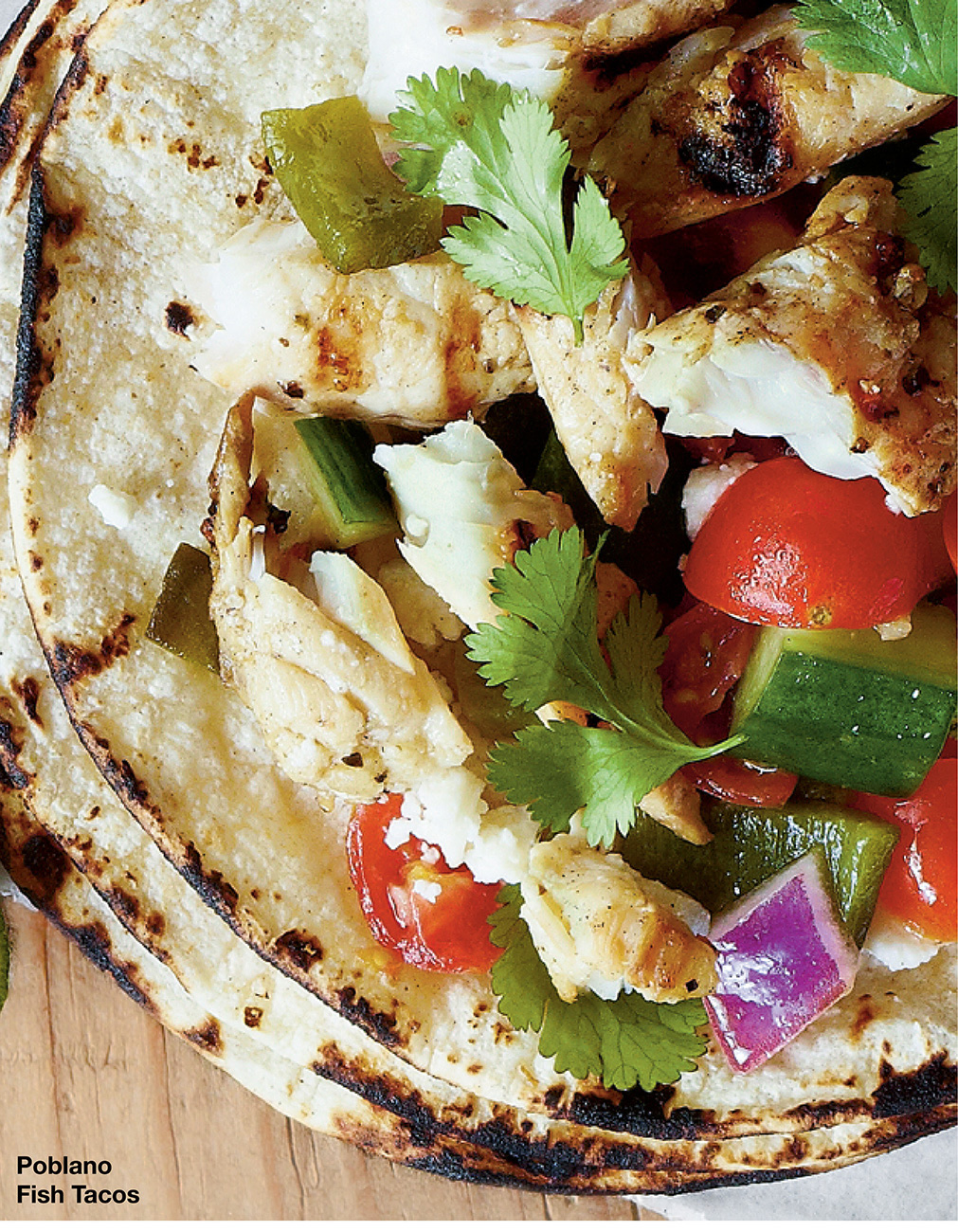
Poblano Fish Tacos
Makes 6 servings Hands-On Time 22 min. Total Time 40 min.
1 large poblano pepper
1/2 English cucumber, coarsely chopped
1 cup grape tomatoes, quartered
2 Tbsp. chopped red onion
1 garlic clove, minced
1/2 tsp. table salt
3 Tbsp. fresh lime juice, divided
4 Tbsp. olive oil, divided
1 Tbsp. mango-lime seafood seasoning
1 1/2 lb. grouper or other firm white fish fillets
12 (6-inch) fajita-size corn tortillas, warmed
Garnish: crumbled queso fresco (fresh Mexican cheese)
1. Preheat grill to 350° to 400° (medium-high) heat. Grill pepper, covered with grill lid, 3 to 4 minutes or until pepper looks blistered, turning once. Place pepper in a large zip-top plastic freezer bag; seal and let stand 10 minutes to loosen skin. Peel pepper; remove and discard seeds. Coarsely chop.
2. Combine pepper, cucumber, next 4 ingredients, 2 Tbsp. lime juice, and 2 Tbsp. olive oil in a bowl.
3. Whisk together seafood seasoning and remaining 1 Tbsp. lime juice and 2 Tbsp. olive oil in a large shallow dish or zip-top plastic freezer bag; add fish, turning to coat. Cover or seal, and chill 5 minutes, turning once. Remove fish from marinade, discarding marinade.
4. Grill fish, covered with grill lid, 3 to 4 minutes on each side or just until fish begins to flake when poked with the tip of a sharp knife and is opaque in center. Cool 5 minutes. Flake fish into bite-size pieces.
5. Serve fish and salsa in warm tortillas.
Note: We tested with Weber Mango Lime Seafood Seasoning.
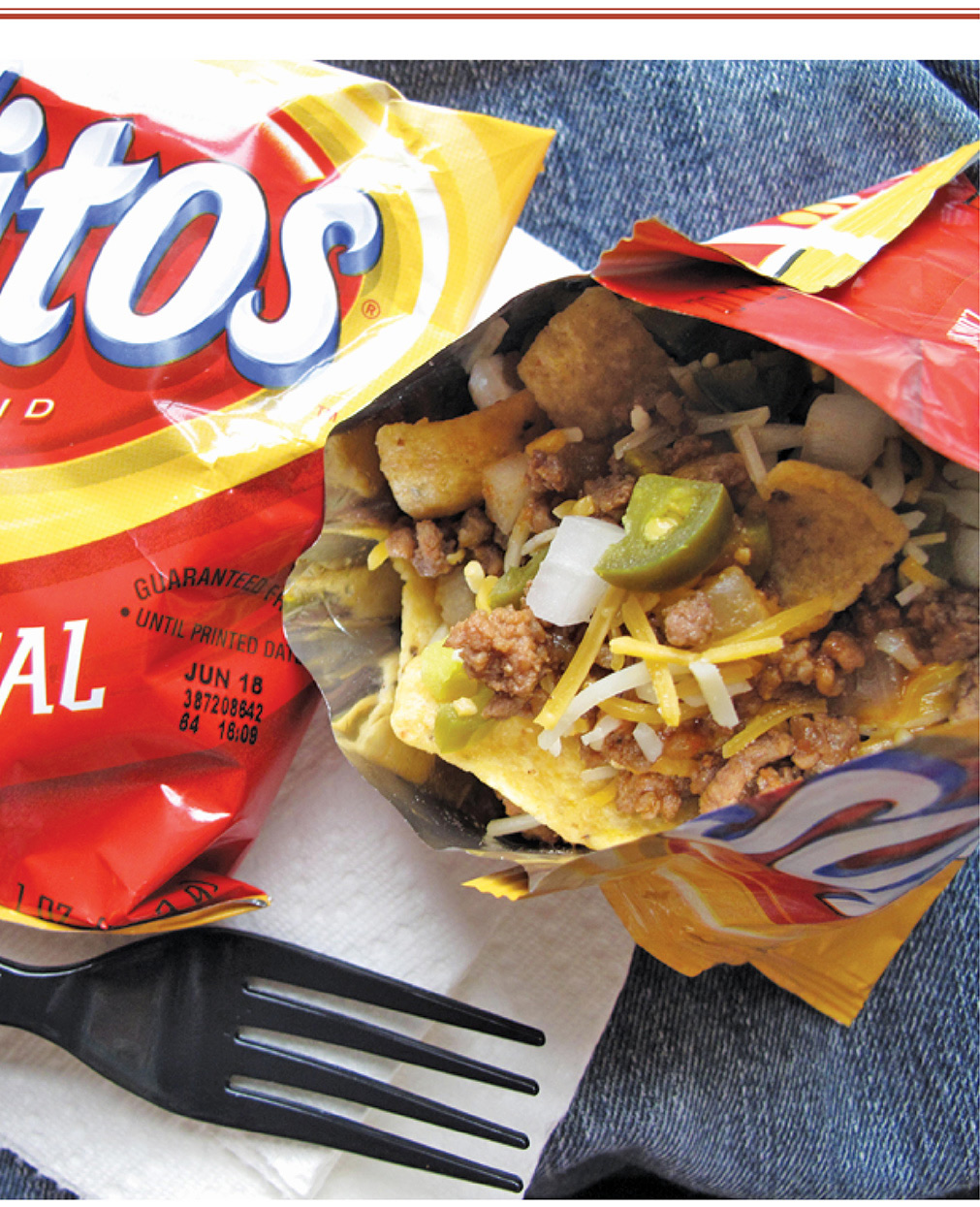
Eat
Frito Pie
Like a Local
The recipe is simple: Take a small bag of Fritos corn chips. Slit it lengthwise down the side. Pour in some chili (ground beef, please), and add some grated sharp Cheddar, some pickled jalapeño slices, and some chopped onion. Eaten right out of the bag, it’s a crunchy, salty, spicy, addictive pleasure.
According to most food historians, it traces to Daisy Dean Doolin, mother of C. E. “Elmer” Doolin, the San Antonio man who introduced America to Fritos in 1932. Elmer tried some fried corn strips made by a Mexican man in accordance with the popular Mexican beach snack fritos, or “little fried things.” He then bought that guy out of his business and started his own, eventually turning the idea into one of the world’s most beloved snack foods. His mom created the Frito pie recipe.
Texans consume Frito pie at most high-school and Little League games, at the Avalon Diner in Houston’s River Oaks (where it’s been on the menu since 1938), and all over the state in venues of high and low culture.Houston foodies endorse the Frito pie at Refresqueria Rio Verde, a food truck often parked at the New Flea Market along Long Point Road.


Tex-Mex Grilled Beef with Green Tomatoes, Corn, and Chipotle-Lime Cream
Makes 4 servings Hands-On Time 15 min. Total Time 40 min.
1 Tbsp. vegetable oil
1 tsp. chili powder
1 tsp. ground cumin
1/2 tsp. table salt
2 (8- to 10-oz.) beef shoulder tender petite roasts or beef chuck steaks
2 green tomatoes, cut into 1/2-inch-thick slices
4 ears fresh corn, husks removed
Vegetable oil
1/4 tsp. table salt
1/4 tsp. black pepper
1. Stir together oil and next 3 ingredients; rub both sides of roasts with oil mixture. Set roasts aside.
2. Brush tomato slices and corn with vegetable oil. Sprinkle tomato slices evenly with 1/4 tsp. salt and 1/4 tsp. pepper.
3. Lightly grease cold grill cooking grate; place on grill, and preheat grill to 300° to 350° (medium) heat. Place beef, tomatoes, and corn on grate. Grill roasts, covered with grill lid, for 7 to 9 minutes on each side, tomatoes for 5 to 7 minutes on each side or until tender, and corn for 15 to 18 minutes or until tender. Let beef stand 5 minutes; cut into thin slices. Serve with tomatoes, corn, and Chipotle-Lime Cream.
1 cup sour cream
2 Tbsp. chopped fresh cilantro
2 tsp. lime zest
1 Tbsp. fresh lime juice
1 tsp. seeded chipotle pepper in adobo sauce, minced
1/2 tsp. sugar
1/4 tsp. table salt
1. Stir together sour cream and remaining ingredients; cover and chill, if desired.

~ A Recipe from a Local ~
Tacos al Pastor
Pineapple softens the pork in this flavorful stove-top version of the Mexican dish. In restaurants, the pork is often stacked onto and roasted on a vertical spit and then shaved for tacos. Al pastor means “in the style of the shepherd,” a reference to the spit-roasting method used with lamb in many cultures.
Makes 6 tacos Hands-On Time 15 min. Total Time 4 hours, 25 min.
1 lb. pork tenderloin, cut into 1/2-inch cubes
1 (8-oz.) can pineapple tidbits in juice, drained
1 medium onion, chopped
1/4 cup chopped fresh cilantro
1 Tbsp. Mexican-style chili powder
1 tsp. ground cumin
1 tsp. dried oregano
1 tsp. black pepper
1 tsp. chopped garlic
3/4 tsp. table salt
1 Tbsp. canola oil
6 (8-inch) soft taco-size corn or flour tortillas, warmed
Toppings: chopped radishes and onions; sliced jalapeño peppers; fresh cilantro leaves and crumbled queso fresco (fresh Mexican cheese)
1. Combine pork and next 9 ingredients in a large zip-top plastic freezer bag. Seal and chill 4 to 24 hours.
2. Cook pork mixture in hot oil in a large nonstick skillet over medium-high heat, stirring often, 10 minutes or until pork reaches desired degree of doneness. Serve with warm tortillas and desired toppings.
Note: We tested with McCormick Gourmet Collection Mexican-Style Chili Powder.
For Spicy Chicken-Pineapple Tacos: Substitute 1 lb. skinned and boned chicken thighs, chopped, for pork tenderloin.
Owner Maria Corbalan, Taco Xpress
Austin, Texas

Eat
Puffy Tacos
Like a Local
Though Austin and other southern cities also lay claim to the invention of the puffy taco, San Antonio’s Tex-Mex restaurants are famous for it—especially Ray’s Drive Inn, Lucy’s Kitchen, Torres Taco Haven, Joe T. Garcia’s, and Henry’s Puffy Tacos, where they are filled with everything from bacon and eggs at breakfast to barbecue at lunch.
The traditional filling is a kind of ground beef stewed with onions, bell peppers, garlic, cumin, and tomatoes. A good puffy taco should be relatively crisp, and should be stuffed and eaten soon after leaving the fryer so as to avoid sogginess. At its best, it is a celebration of textures—the crunchy outside, the gooey inside, the crumbly meat, the melting cheese, the crisp lettuce, the creamy sour cream.
A puffy taco is as good as a regular taco, only better: a great example of why Texas’s “more is more” is sometimes a very good thing.


You are met with music in this city from the minute your plane sets down. Literally. There is live music in Austin’s airport terminals, grocery stores, and even the City Council meetings. And that’s all before you get to the clubs, bars, coffeehouses, taquerias, and concert halls.
By most counts, there are more than 200 live music venues in Austin. Most folks trace this tradition to the 1933 opening of Threadgill’s, a club Janis Joplin later made famous. Other now-legendary clubs followed: Liberty Lunch (closed in 1999), the Victory Grill (frequent home of blues legend B.B. King), and Armadillo World Headquarters (closed in 1980). By 1976, when Austin City Limits (the longest running live music TV show) debuted, Austin’s music scene was going full-throttle.
From jazz to punk, music of all kinds thrives in Austin, but the town has its own special flavor. Some call it honky-tonk, others prefer twang. It’s a kind of country-blues hybrid than can be either rollicking or homespun and rustically serious, depending on the performer and venue. Music aficionados divide the city into eight neighborhood music “districts,” including the Warehouse District, the Market District, the University of Texas, and Red River.
And don’t forget the music festivals, which Austin hosts at least once a month. At the Swamp Thing and Crawfish Festival in April, you can eat crawfish with your fingers while listening to zydeco. May is officially dedicated to Latino music and includes the Pachanga Music Festival.
Austin has many hidden charms, but music is one that is out in the wide open.
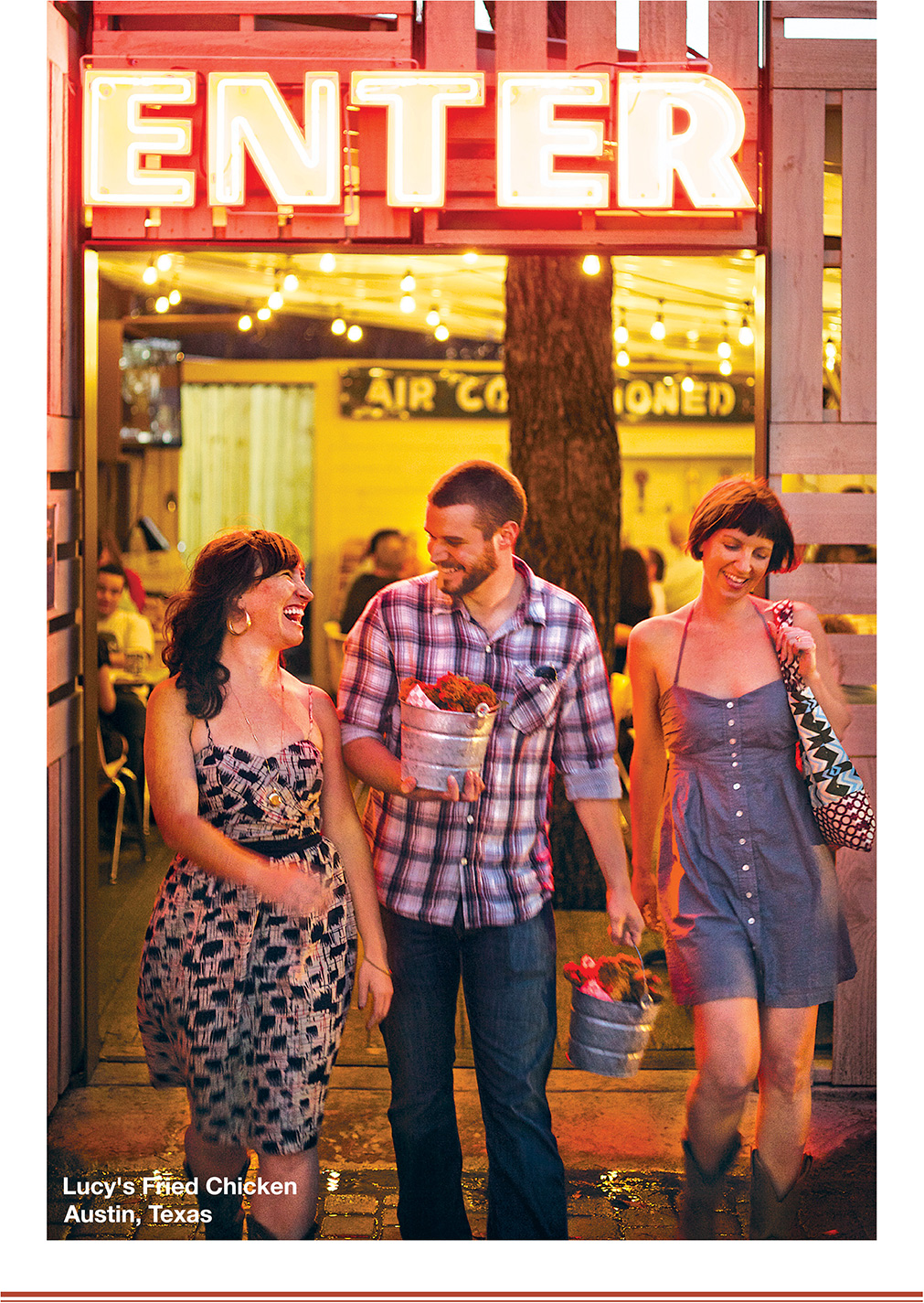
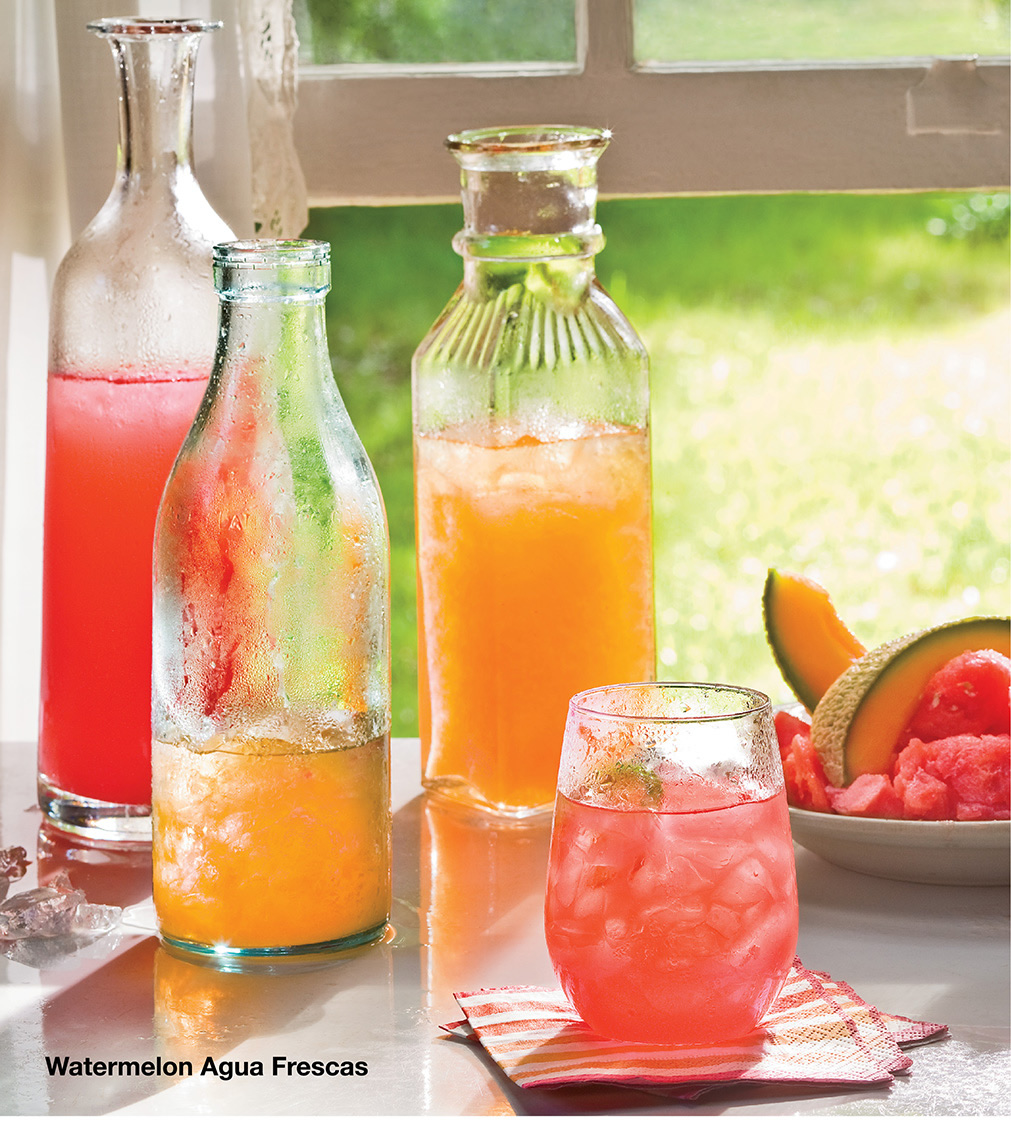
~ A Recipe from a Local ~
Watermelon Agua Frescas
Makes about 5 cups Hands-On Time 10 min. Total Time 10 min.
4 cups cubed seedless watermelon, cantaloupe, or honeydew melon
1/4 cup sugar
2 cups cold water
1. Process watermelon, cantaloupe, or honeydew melon and sugar in a blender until smooth, stopping to scrape down sides as needed. Pour mixture through a fine wire-mesh strainer into a pitcher, discarding solids. Stir in 2 cups cold water. Cover and chill until ready to serve. Serve over ice.
Owner Maria Corbalan, Taco Xpress
Austin, Texas

~ A Recipe from a Local ~
Avocado Soup
Cool down with this cold, creamy soup.
Makes 8 cups Hands-On Time 15 min. Total Time 1 hour, 15 min.
4 avocados, peeled and quartered
1 tsp. table salt
1 tsp. green hot sauce
1 (14.5-oz.) can chicken broth
1 1/2 cups half-and-half
1 (8-oz.) container sour cream
1/4 cup Johannisberg Riesling
3 Tbsp. lime juice
Garnish: thinly sliced green onions
1. Process avocados and next 3 ingredients in a blender or food processor until smooth, stopping to scrape down sides.
2. Pour mixture into a large bowl; stir in half-and-half and next 3 ingredients until smooth. Place plastic wrap directly over soup; chill 1 hour.
Note: Off-dry white wines such as Gewürztraminer or Chenin Blanc may be substituted.
Susan Auler
Austin, Texas

~ A Recipe from a Local ~
Southwest Watermelon Salad
Use reserved watermelon from the Pickled Watermelon Rind for this recipe.
Makes 8 to 10 servings Hands-On Time 30 min. Total Time 2 hours, 5 min., plus 2 days for chilling the rind
4 cups seeded and cubed red watermelon
4 cups seeded and cubed yellow watermelon
2 Tbsp. sugar
1 Tbsp. lime zest
2 Tbsp. fresh lime juice
1/2 cup Pickled Watermelon Rind
1/4 cup coarsely chopped fresh cilantro
1/4 cup coarsely chopped fresh basil
1 Tbsp. chopped fresh chives
1 Tbsp. seeded and thinly sliced jalapeño pepper
1 Tbsp. thinly sliced shallots
1 tsp. minced garlic
2 Tbsp. olive oil
1/2 cup crumbled Cotija or feta cheese
1. Combine first 5 ingredients in a large glass bowl. Stir in Pickled Watermelon Rind and next 6 ingredients. Drizzle with oil; sprinkle with cheese. Serve immediately, or cover and chill up to 2 hours.
Pickled Watermelon Rind
Makes 1 qt. Hands-On Time 30 min. Total Time 1 hour, 35 min., plus 2 days for chilling
1/2 small watermelon (about 5 lb.)
3 Tbsp. table salt
3/4 cup sugar
3/4 cup vinegar
2 star anise
1. Remove rind from watermelon, leaving a small amount of red flesh attached to rind. Reserve watermelon flesh for another use. Peel rind, and cut into 1-inch cubes (about 5 cups cubed). Place in a large bowl.
2. Stir together salt and 3 cups water. Pour over rind. Cover and chill 24 hours. Drain; rinse well.
3. Combine rind, sugar, next 2 ingredients, and 3⁄4 cup water in a large Dutch oven. Bring to a boil; remove from heat. Cool completely (about 1 hour), stirring occasionally. Cover and chill 24 hours before serving. Refrigerate in an airtight container up to 1 week.
Chef Shawn Cirkiel, Parkside
Austin, Texas

~ You've Gotta Try ~
King Ranch Chicken Casserole
King, sold as a child by his destitute family into servitude to a New York City jeweler, ran away and made his way by steamboat to Texas in search of fortune. He found it as a steamship captain running Union blockades under a Mexican flag during the Civil War. He bought a whole lot of land with some partners after that, with the dream of combining the best of Southern plantation culture and the best of Mexican hacienda life.
The ranch, situated between Corpus Christi and Brownsville, was known for its epic cattle drives and expansive way of life. In 1933, oil was discovered there as well. Thoroughbred horses still are raised on the ranch, now a national historic landmark that you can tour.
The extremely popular and beloved casserole that bears its name, known to Texas cooks everywhere, is an institution of its own.
Though it’s obviously named for the ranch and clearly embodies the mixture of Mexican and Southern flavor that King built there, historians say it’s unclear if the dish actually originated on the ranch. And some King descendants claim the ranch was more associated with meat and game dishes than with poultry dishes like this one. It’s a rich and easy Tex-Mex delight either way.

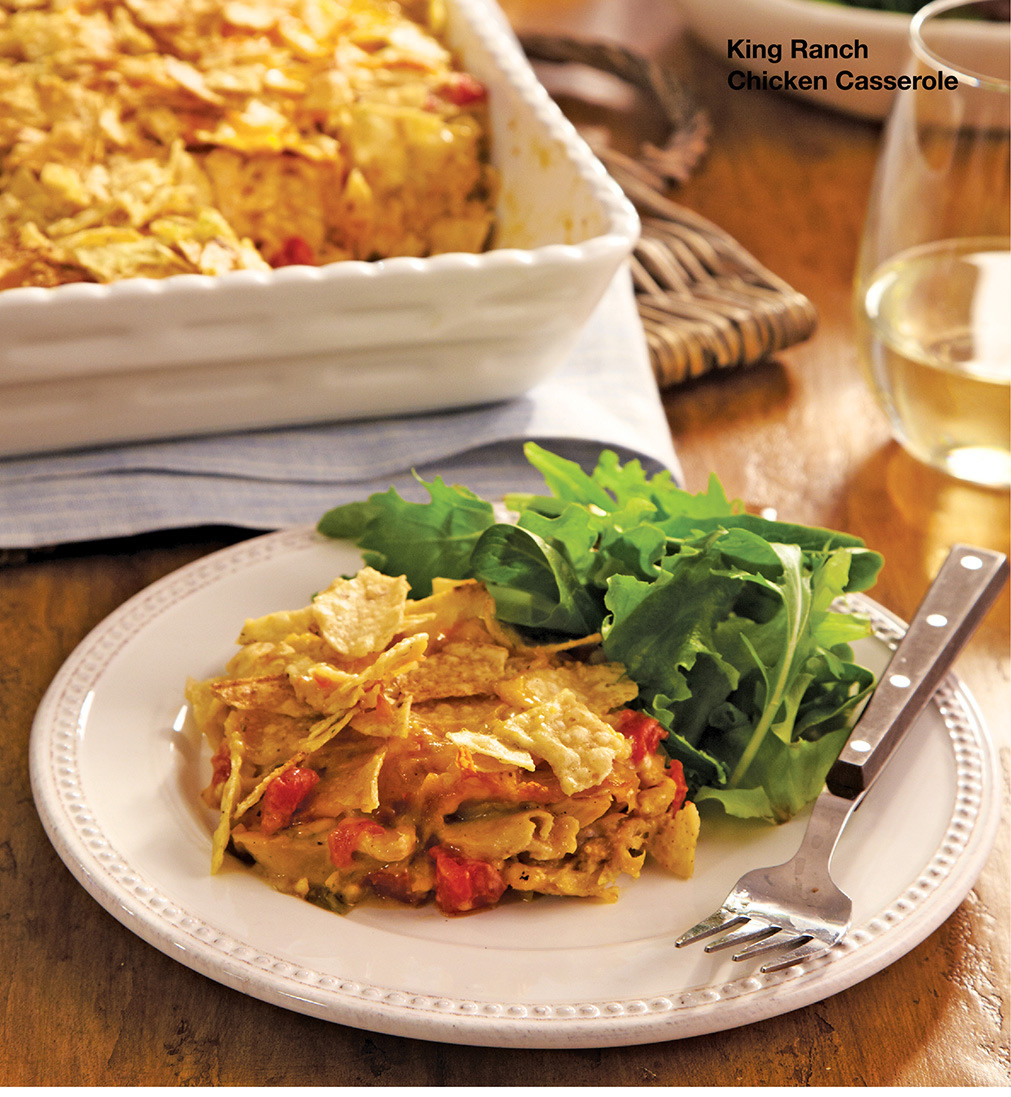
King Ranch Chicken Casserole
Makes 8 to 10 servings Hands-On Time 30 min. Total Time 3 hours, 30 min.
1 (4 1/2- to 5-lb. ) whole chicken
2 celery ribs, cut into 3 pieces each
2 carrots, cut into 3 pieces each
2 1/2 to 3 tsp. table salt
2 Tbsp. butter
1 medium onion, chopped
1 medium-size green bell pepper, chopped
1 garlic clove, pressed
1 (10 3/4-oz.) can cream of mushroom soup
1 (10 3/4-oz.) can cream of chicken soup
2 (10-oz.) cans diced tomatoes and green chiles, drained
1 tsp. dried oregano
1 tsp. ground cumin
1 tsp. Mexican-style chili powder*
3 cups (12 oz.) shredded sharp Cheddar cheese
12 (6-inch) fajita-size corn tortillas, cut into 1/2-inch strips
1. If applicable, remove giblets from chicken, and reserve for another use. Rinse chicken.
2. Place chicken, celery, carrots, and salt in a large Dutch oven with water to cover. Bring to a boil over medium-high heat; reduce heat to low. Cover and simmer 50 minutes to 1 hour or until chicken reaches desired degree of doneness. Remove from heat. Remove chicken from broth; cool 30 minutes. Remove and reserve 3/4 cup cooking liquid. Strain any remaining cooking liquid, and reserve for another use.
3. Preheat oven to 350°. Melt butter in a large skillet over medium-high heat. Add onion, and sauté 6 to 7 minutes or until tender. Add bell pepper and garlic, and sauté 3 to 4 minutes. Stir in reserved 3/4 cup cooking liquid, cream of mushroom soup, and next 5 ingredients. Cook, stirring occasionally, for 8 minutes.
4. Skin and bone chicken; shred meat into bite-size pieces. Layer half of chicken in a lightly greased 13- x 9-inch baking dish. Top with half of soup mixture and 1 cup Cheddar cheese. Cover with half of corn tortilla strips. Repeat layers once. Top with remaining 1 cup cheese.
5. Bake at 350° for 55 minutes to 1 hour or until bubbly. Let stand 10 minutes before serving.
Note: You can substitute 1 tsp. chili powder and 1⁄8 tsp. ground red pepper for the Mexican-style chili powder.
For Quick-and-Easy King Ranch Chicken Casserole (pictured): Substitute 1 (2-lb.) skinned, boned, and shredded deli-roasted chicken for whole chicken, 3 cups coarsely crumbled lime-flavored white corn tortilla chips for corn tortillas, and 3/4 cup chicken broth for cooking liquid. Omit celery, carrots, and salt. Prepare recipe as directed, beginning with Step 3.
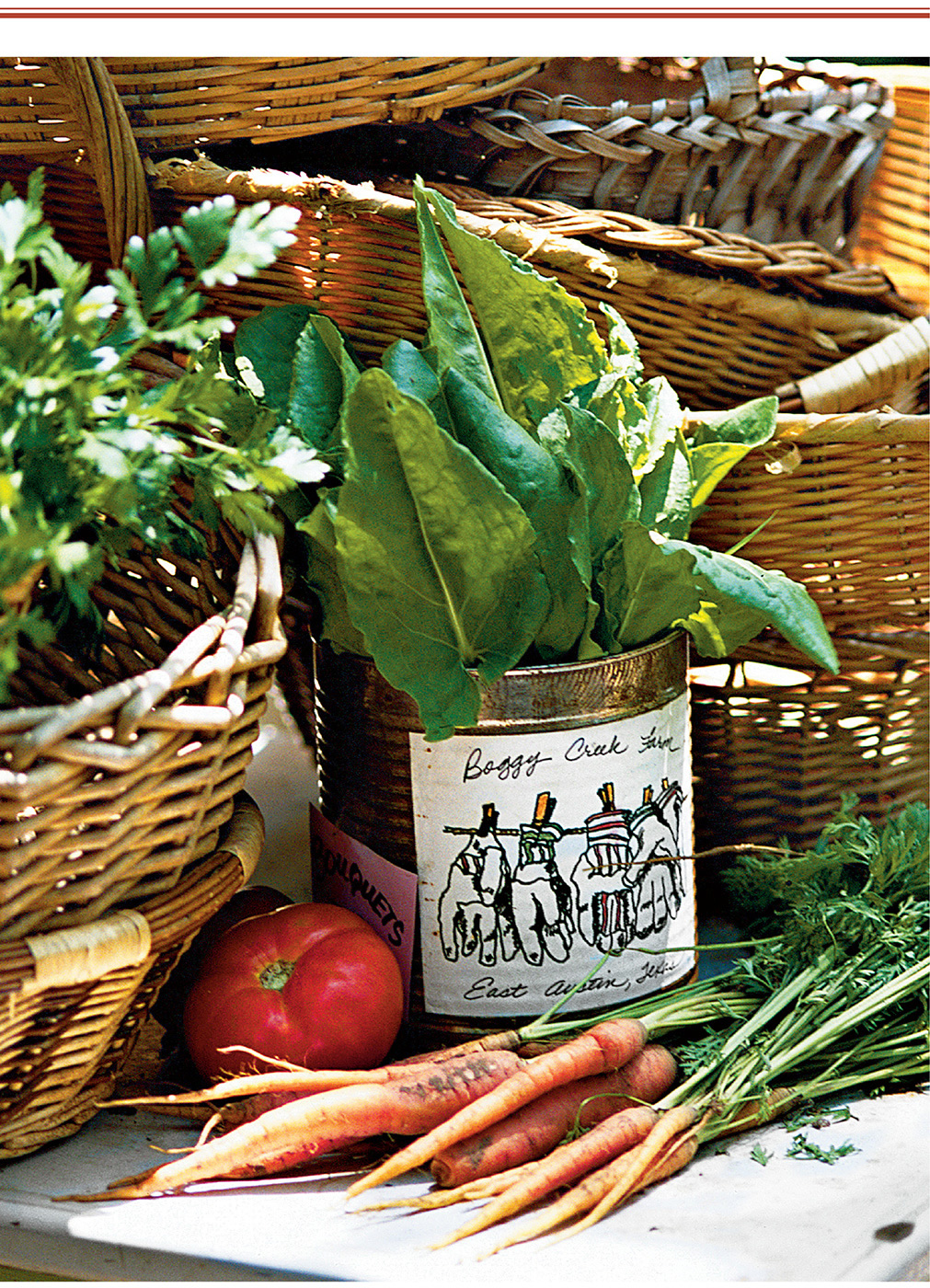
Shop at
Boggy Creek Farm
Like a Local
When that happens, on Wednesdays and Saturdays, you want to be there.
Butler and Sayle sit on their front porch, welcoming visitors and selling their farm-fresh sunflowers, herbs, veggies (okra, eggplants, radishes), and fruit (figs, peaches, pears)—more than 100 crops total, including pecans from the giant trees lining the property.
These crops have been grown on their land since the late 1830s, long before “urban farming” and “locavore” became buzzwords. Boggy Creek is a marvelous place to linger awhile in the fields and get in touch with where your food comes from. The farm also supplies Whole Foods, but it’s a whole lot more fun to buy it here.
Bonus: At the farm, you get to see what “eating a rainbow” means. Sayle, a former artist, assembles gorgeous piled-high displays, tables, and baskets of produce and flowers.


~ A Recipe from a Local ~
Grilled Tri-Tip with Citrus-Chile Butter
The tri-tip cut of beef is a thick and flavorful cut of lean bottom sirloin that is tender enough to serve medium-rare.
Makes 8 to 10 servings Hands-On Time 30 min. Total Time 40 min.
2 (2-lb.) tri-tip steaks or 2 lb. (2-inch-thick) strip steaks
2 tsp. table salt, divided
1 1/4 tsp. black pepper, divided
3 bunches baby Vidalia or green onions, trimmed
3 Tbsp. olive oil
1. Preheat grill to 350° to 400° (medium-high) heat. Sprinkle steaks with 1 1/2 tsp. salt and 1 tsp. pepper. Grill steaks, covered with grill lid, 9 to 12 minutes on each side or to desired degree of doneness.
2. Remove from grill, and rub 3 Tbsp. Citrus-Chile Butter onto steaks. Cover steaks with aluminum foil; let stand 5 minutes.
3. Meanwhile, toss onions with olive oil; season with remaining 1/2 tsp. salt and 1/4 tsp. pepper. Grill onions, without grill lid, 2 minutes; turn and grill 1 more minute.
4. Uncover steaks, and cut diagonally across the grain into thin slices. Serve with grilled onions and remaining Citrus-Chile Butter.
1 cup butter, softened
2 Tbsp. lime zest
2 Tbsp. lemon zest
3 garlic cloves, minced
1 Tbsp. seeded and minced jalapeño pepper
1 tsp. chopped fresh thyme
1. Stir together all ingredients. Season with table salt and freshly ground black pepper to taste. Cover and chill until ready to serve, or shape into a log with plastic wrap, and freeze up to 1 month.
Chef Shawn Cirkiel, Parkside
Austin, Texas
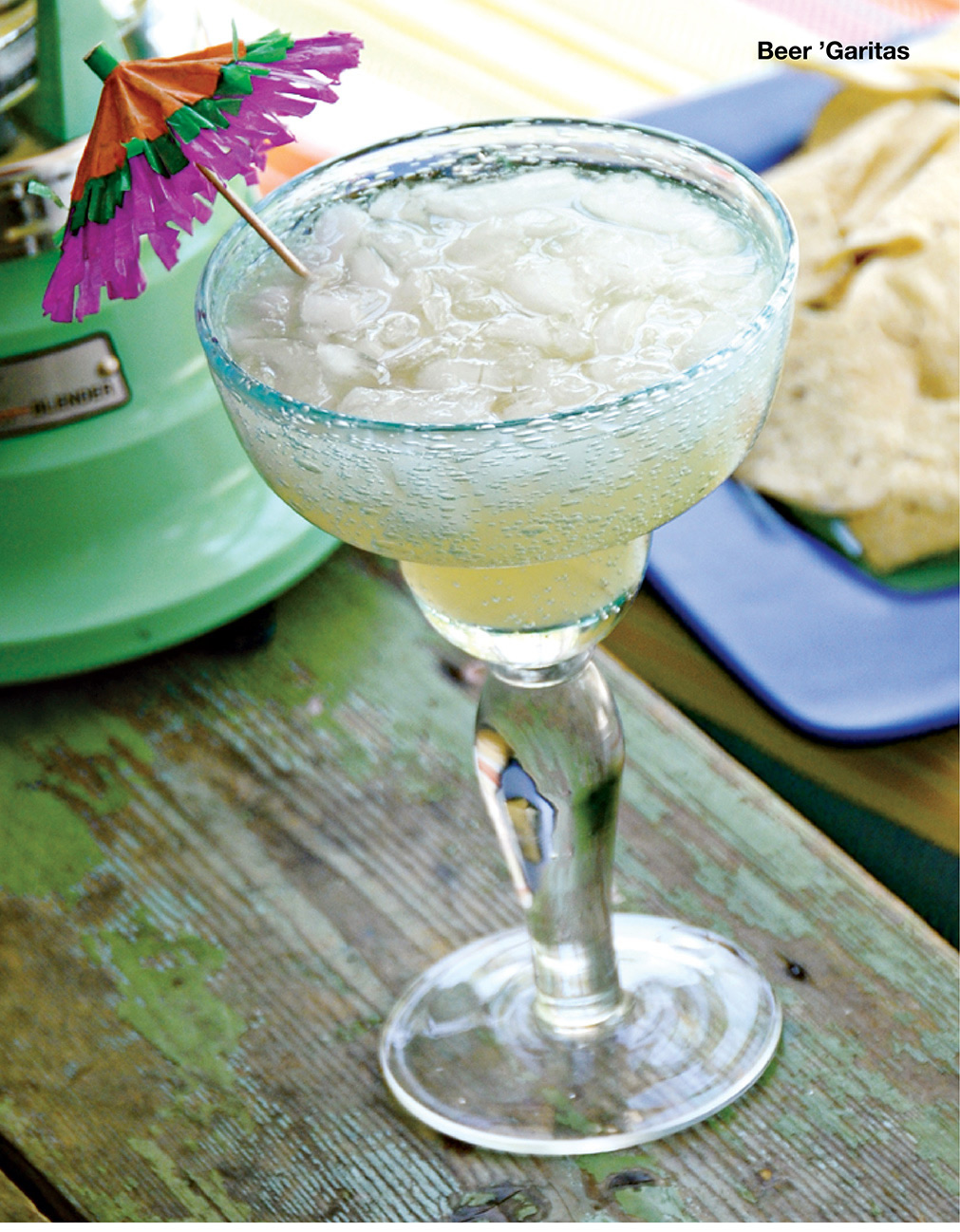
Beer ’Garitas
For fast measuring and one less dirtied measuring cup, use the empty limeade can to measure the tequila. One 12-ounce can is equivalent to 1 1/2 cups.
Makes 6 cups Hands-On Time 5 min. Total Time 5 min.
1 (12-oz.) container frozen limeade concentrate, thawed
1 1/2 cups tequila
2 (12-oz.) bottles beer
Crushed ice
1. Stir together first 3 ingredients in a large pitcher until blended. Serve immediately over crushed ice in salt-rimmed glasses, if desired.

Remember
LBJ and Lady Bird
Like a Local
The highlight of Johnson’s personal life, however, was probably his 1934 marriage to Claudia “Lady Bird” Taylor, who acquired her nickname from a baby nurse who said that she was “purty as a ladybird.” Johnson met her when he was a congressional secretary visiting Austin on official business, and legend had it that he applied his charms to courting her so intensely that she had little choice but to marry him—after only seven weeks.
Lady Bird was a tireless campaigner: In 1960, she covered 35,000 miles for the Kennedy and Johnson ticket, and in 1964, she campaigned independently on a whistle-stop train throughout the South for the Johnson and Humphrey ticket. When LBJ was in the Navy in World War II, she managed his congressional office in his stead. And when, as Senate Majority Leader, he had a massive heart attack in 1955, Lady Bird managed his staff until he recovered.
Her personal passion, though, was nature and the environment. An avid gardener, she co-authored the book Wildflowers Across America and led the charge to get Congress to enact the Highway Beautification Act of 1965, which spruced up roadsides all over the country. At the age of 70, she co-founded the National Wildflower Research Center. Later renamed the Lady Bird Johnson Wildflower Center, it’s dedicated to preserving and re-establishing native plants. She died in 2007 at the age of 94, one of the most beloved First Ladies of all time.


White House Pecan Pie
When Cecily Brownstone, veteran food reporter for The Associated Press, visited the Johnson White House in 1964, she came back with this recipe. The pecan pie Lady Bird shared was from the Johnson family’s longtime cook, Zephyr Wright, whose comfort food was legendary. “Small portions of this pie are in order,” advised Brownstone, “even if you have as much energy as our admirably zestful and gracious First Lady.”
Makes 8 servings Hands-On Time 10 min. Total Time 5 hours, 50 min.
1/2 cup butter
1 cup sugar
1 cup dark corn syrup
1/2 tsp. table salt
1 1/2 tsp. vanilla extract
3 large eggs
2 cups coarsely chopped pecans
1 (9-inch) unbaked piecrust shell
Unsweetened whipped cream (optional)
1. Preheat oven to 375°. Allow the butter to stand in a covered medium mixing bowl at room temperature until it is extremely soft. Add sugar, corn syrup, salt, and vanilla; with a mixing spoon, beat until thoroughly blended. Add the eggs, and beat gently until just blended. Fold in the pecans. Pour into piecrust shell.
2. Place in oven on the rack directly below the center rack, and bake at 375° for 40 to 50 minutes or until top is toasted brown and filling is set in center when pie is gently shaken. Pastry edge should be browned and pastry bottom a pale gold. If top of pie gets very dark toward end of baking time, place a tent of foil over it. Cool completely on wire rack (about 5 hours). If desired, serve with unsweetened whipped cream.